
Ever wondered how many SEO factors do search engines like Google take into account while ranking websites?
There are an astounding 200+ Google ranking factors under the sun that can be optimized for improving the visibility and utility of a website. But tweaking all of them is futile as many of them only marginally affect your website’s Google ranking over a long period of time.
However, there is no denying that tweaking the most important factors among them will certainly give your website a better standing in the search engine rankings which is, after all, great for increasing website traffic, attracting leads and effecting conversions.

Without further ado, we delve into the top 15 Google ranking factors that you must optimize for your business website in 2022:
Content’s length and depth

Many studies claim that the average Google first page result contains 1447 words. However, remember that your web page’s copy should help users and not the search bots.
Your content must complete users’ goals which could be getting detailed information on a topic (e.g. ‘art history of Renaissance’), getting quick answers to a question (e.g. ‘Nasdaq-100 index today’), or merely looking up a product’s description (e.g. ‘Tesla Model X features and specs’).
If the copy is relevant to what users’ are looking for, the web page will do better in Google search ranking. In fact, John Mueller, Webmaster Trends Analyst at Google, emphasized on a copy’s quality in his tweet few years ago.
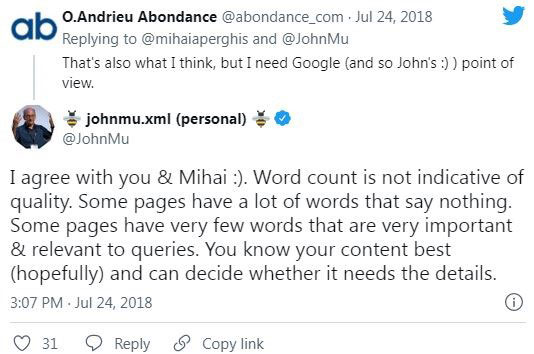
Although long-form content can capture more information, eventually it must be relevant to what the online users are looking for in terms of expertise, authoritativeness and trustworthiness (or E-A-T).
Furthermore, the Quality Raters Guidelines published by Google lays criteria for, and instructs, Quality Raters to rate a page as ‘Low’ if it is of substandard quality and ‘Lowest’ if it’s untrustworthy, misleading & harmful. So, a balance between content’s volume and value is crucial to fare well in Google search ranking.
Backlinks: relevance and authority

Arguably the most important among the Google ranking factors, backlinks link one website to another. If there are many websites with backlinks to your business website, Google sees those links as votes of confidence for your site. It sees your website as relevant and credible.
By checking for new links, search engines look up new content by revisiting the other popular pages they’ve already ‘recognized’ earlier. It helps the engines to discover your website’s content faster if those popular pages have backlinks to your website.
When users click a backlink, your website garners referral traffic. Further, if you own a website that sells electronic gadgets, a backlink about ‘wireless headphone discount offers’ has more relevance for your website than a backlink ‘food joints in my area’ has. In other words, relevant backlinks matter for your website.
Backlinks transfer authority to your website. However, a web page with many outbound links (one of which is a link to your website) transfers lesser authority as compared to a web page that has only two outbound links, one of them being a link to your website.
Furthermore, here’s what Google co-founders Sergey Brin and Larry Page described about PageRank in their original paper:

Page speed: UX perspective
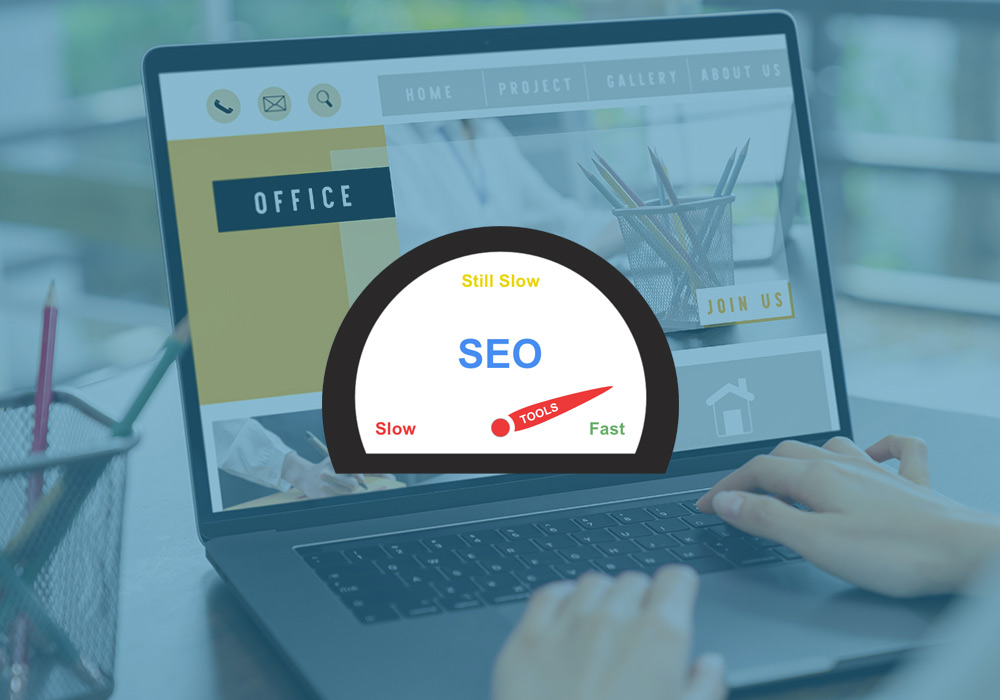
In 2018, Google published the findings of a neural network it had modeled to study bounce rates and conversions relative to mobile pages.
With a 90% prediction accuracy, the neural net found that the bounce rate probability rose to 123% as the TTL (time to load) rose from 1 second to 10 seconds.
Similarly, probability of conversion drops by 95% if the number of elements on the page (like images, text, etc.) increase from 400 to 6000.Valuing the user experience above all else, Google has invested in thousands of data centers globally to serve results as quickly as possible.
As a website owner, you can understand visitors pogosticking if your site’s pages don’t load quickly. Quick load times (1-2 seconds for very fast pages andMobile friendliness

Unlike the earlier desktop-first indexing used by Google to determine the relevance of a web page to user’s search query, it’s predominantly using mobile-first indexing officially since March 2021.
Mobile traffic has overtaken desktop traffic. Over 54% of the online traffic came from mobile devices in the first quarter of 2021. It is crucial that your mobile site’s primary content be same as your desktop version.
Make sure Google’s smartphone agent, Googlebot, can access and render your mobile page content & resources just as it would do for your website’s desktop version. You can go through the technical know-how here.
Image optimization

According to Google Search Central, adding more context around the images (through image captions, alt text having keywords, and badges) increases their usefulness, which can lead to higher quality traffic to your site. You can aid in the discovery process by making sure that your images and your site are optimized for Google Images by including structured data for product, video, and recipe.
Here are the differences in results for the same search query. The right-hand side results have image captions highlighted in red boxes.
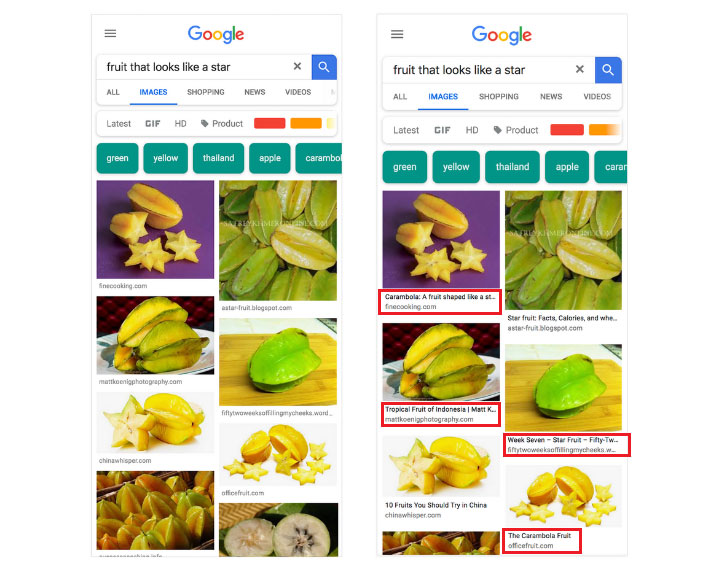
Captions describe the picture and users find it helpful. If your website has pics well optimized for Google Images, more traffic will head your way.
You can learn in-depth about more image optimization tweaks here.On-page SEO and keywords

Patching missing metadata, mending/redirecting broken links, updating the actual content as well as the HTML source code for overall website effectiveness – all this and more such tweaks comprise on-page SEO.
It helps in information indexation by the crawlers which in turn boosts page’s SEO ranking. It is common in on-page SEO to choose one primary keyword (and 3-4 related keywords), placing it in the URL & embedding the related keywords in the first paragraph (or first 150-200 words) of the content. Organizing the overall content in lists & bullet points is a good practice.
Improve the meta-descriptions and meta-title tags by embedding well-researched keywords and including relevant images in the content.
Freshness of content

Search engines like Google know that sometimes people prefer the latest results for their search queries. As for other queries, freshness might not play a vital role.
For instance, the image below shows results for two searches, ‘best restaurants in London’ and ‘ukraine’ both highlighted in red boxes.
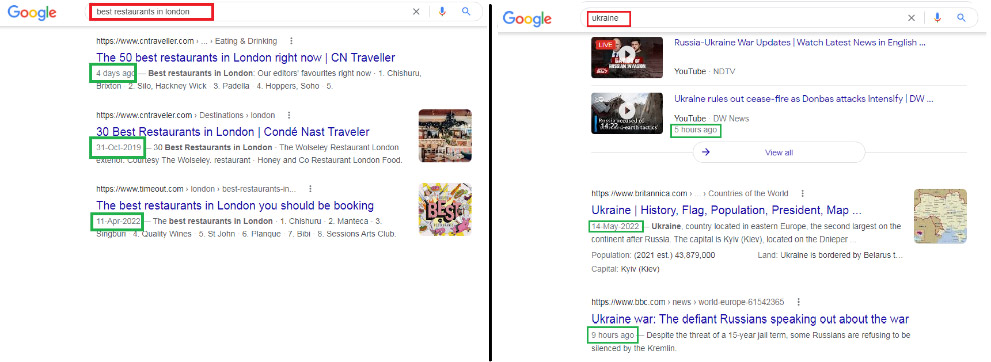
Glancing at the search results and their freshness (as highlighted in green boxes), one can realize that Google knows when to push a particular result to a user’s query even if the user has not specified in the search string how latest a result he/she is expecting.
It is good to keep updating your content so that it stays relevant to the digital populace for a long time. Besides, keywords keep evolving as per users’ searches, making it imperative to upgrade your website to the latest high-quality keywords.
Search intent

Search intent is the intangible ‘expectation’ behind a user’s search. Google sifts through enormous volume of data and coupled with its AI powered algorithms (like RankBrain), it understands user’s search intent fairly well to provide the precise results.
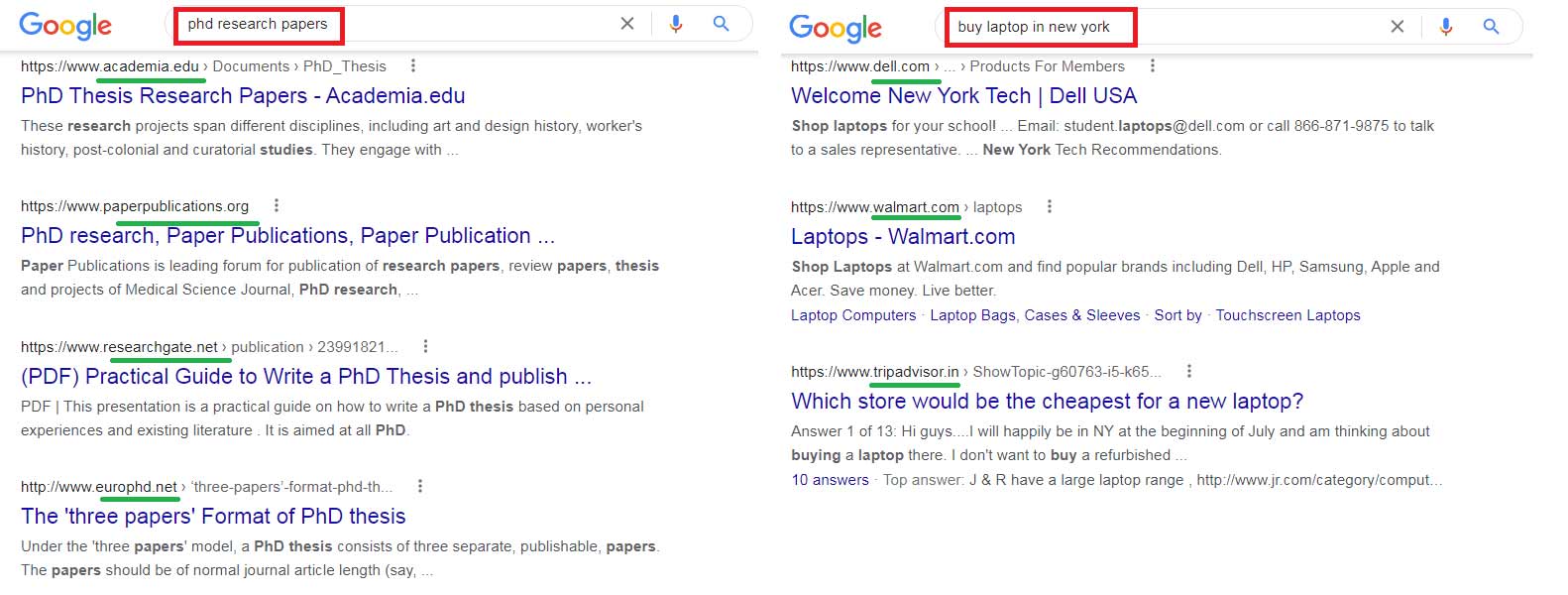
For instance, the above image shows results for two different queries. The search string ‘phd research papers’ fetches links to universities and educational resources. On the other hand, the search string ‘buy laptop in new york’results in links to a laptop manufacturing company and even a retail outlet.
You can optimize your website content for informational intent by using ‘what is/are/was’, ‘how to’, ‘where is/was/are’ etc. in your keywords. Use ‘buy’, ‘best offer’, ‘discount on’ etc. in your keywords to address transactional intent of the user.
The keywords in the URL, headings & metadata determine how accurately your content will map to audience’s intent.
Implementing schema markup in your website’s pages helps the search engines serve more visual results (e.g. star ratings, location, address, designation, PIN code, contact number etc.) to the users.Original content
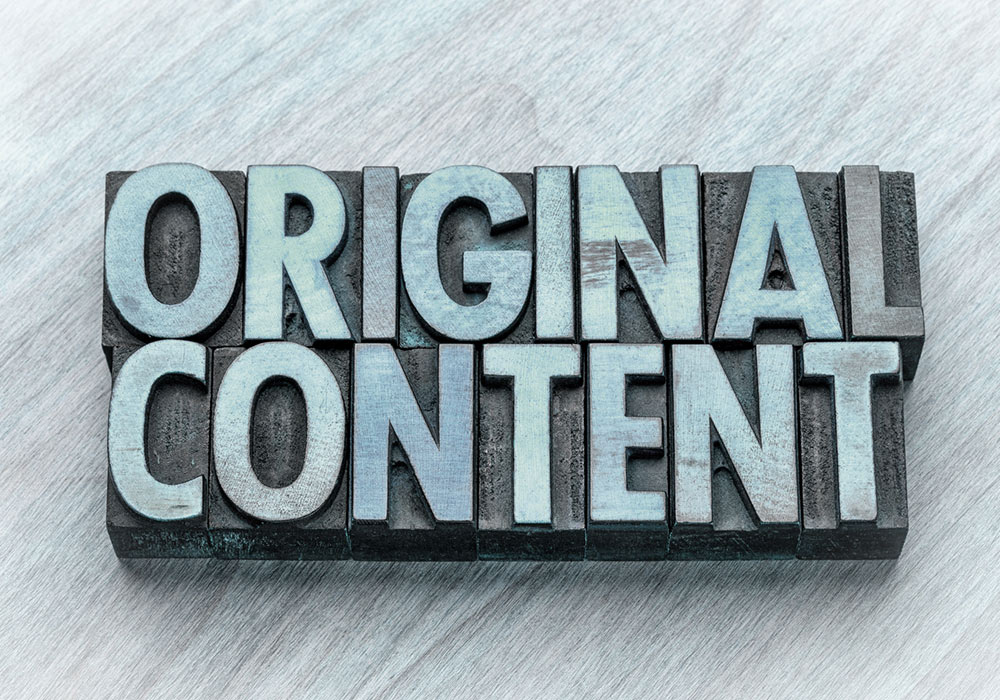
Google loves originality in content. Keep the content on your page original & simple to understand by all user types.
Duplicate content or content copied from (or scraped) from an indexed page prompts Google to penalize your web page and may not index it at all.That’s the least of worries. A DMCA strike may take down your website if copied/plagiarized content on your website gets flagged. So keep it legitimate and simple.
If possible, provide supplementary content (like currency, distance and temperature scale converters) as Google Rater Guidelines consider it indicative of a page’s quality and thus Google ranking.
Internal links: hub and spokes

Hubs are 3 to 4 broad keywords defining the broad categories on site pages. These hubs make up almost all the services, products and knowledge being offered by a business through the website.
Google places much emphasis on internal linking of pages having same keywords in their title tags. The pages rank well so far as they are connected by internal links through a hub page which is a high-level, descriptive page offering links to the other interlinked web pages of your website.
These other interlinked web pages contain long-tail keywords – known as ‘spokes’ – derived from the hubs as mentioned above.

The user search comprising of your hubs (the broad keywords) confers significant authority on your business whereas the long-tail keywords in the ‘spokes’ are largely transactional (i.e. they aid in lead generation).
For instance, ‘SEO marketing’ can be a hub keyword and ‘Hong Kong SEO marketing’, ‘SEO marketing company’, ‘best SEO marketing firm’ etc. are the spokes of the hub.
HTTPS security

In 2014, Google recommended that all websites switch from HTTP to HTTPS to enable secure, encrypted communications between browsers and servers. Simply stated, HTTPS offers a secure connection to the website a user is visiting. It also secures users’ private information (e.g. passwords, card details etc.) during web browsing.
With the launch of Chrome version 68 in 2018, Google started flagging all HTTP sites as ‘not secure’. This prompted other browsers to follow suit.
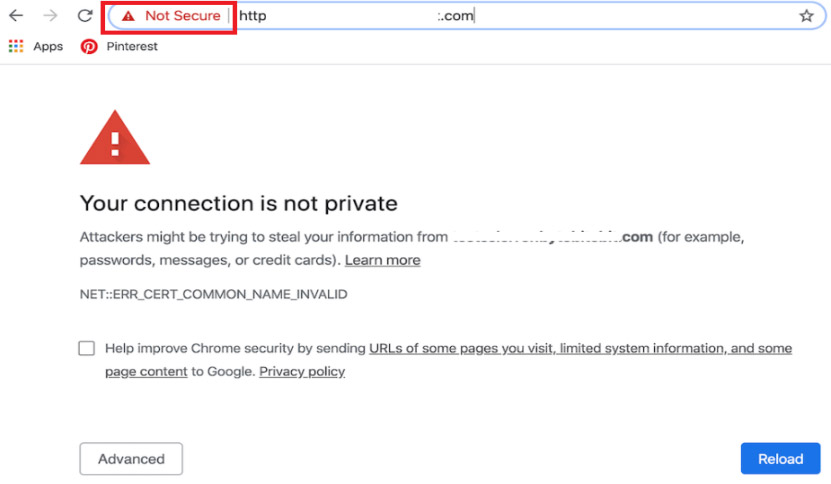
Seeing ‘not secure’ alert promptly drives the users away and as business website owner, you don’t want that. To avoid this precarious scenario, and as an example, WordPress 5.7 makes moving to HTTPS a lot easier through its Site Health feature.
Site Health checks if your WordPress site is running on a hosting account ready for SSL. Once you’ve got an SSL certificate from a hosting provider and your site has moved from HTTP to HTTPS, WordPress updates the URLs in your database.Website architecture & accessibility

This one involves providing the user with easy, smooth navigation throughout your website by ensuring a well-thought out site architecture, with proper breadcrumbs and navigation menus, logical internal links and emphasizing on any web page’s accessibility on your website within 2 or 3 clicks.
Overly complicated menus put off the users which ultimately affects your website’s Google ranking.
On the other hand, if your website is not just easy to navigate but also optimized for especially abled users (shift key navigation, images with descriptive alt text, content with alterable font-size, suitable website color theme for color blinds etc.), it will climb only higher in Google search ranking over time.
Business listings

An optimized Google My Business Profile (GBP) goes a long way in boosting SEO ranking and instils trust in the potential customers.
Add every relevant information about your business in the GBP, keep the profile active and accurate, add your business to local directories – all this adds to the ranking.
With a GBP, your business pops up in the search results of all those third-party apps that use Google Maps to serve their own set of users.Table of contents

Adding a linked table of contents at the beginning of your page helps Google ‘feel’ your page better. It understands the structure of your web page. Also, table of contents can result in sitelinks as well.
Ensure that the text in your page title and sub-headings is informative & compact, and focus on creating a logical site structure that is easy to navigate for users.
According to Google, its systems analyze the link structure of your website to find shortcuts that can save users’ time by allowing them to quickly find the information they are looking for.

Someone who is interested only in the cultural traditions of dancing will go straightaway for the relevant sitelink highlighted in the image above and needn’t peruse the entire Wiki article on dancing.
When users are able to quickly find what they are looking for on your website, they are bound to come back in future and may even initiate a transaction.
User experience

Google’s SEO starter guide emphasizes that all website optimizations should be done to provide the users with the best search experience. Absence of intrusive ads, responsiveness, relevance to users’ search requirements, proper navigation, organized & easily readable content etc. are some of the factors your website must be optimized for.
Signals like clickthrough rate (CTR), dwell time, time on page etc. are taken into consideration by Google to determine your website’s SEO ranking.
So those were the top 15 Google ranking factors you can optimize to improve your website ranking. Our team of experts at Gdata, the Mumbai digital marketing company specializing in SEO, is adept at optimizing websites for the Google ranking factors you went through above just now.
We have an established history of performing on-page and off-page SEO activities that improve
websites’ search engine results within 6 months of beginning the SEO. To know how we accomplish that feat, feel free to reach out to us.
Introduction of new website building tools has led to a sharp growth in website page sizes over the years. Adding pages to a website every now and then is easy but with every plugin addition or complexity in front end development, it becomes important to reevaluate the site performance from time to time. Consequently, website maintenance is of top priority for any business with an online presence today.
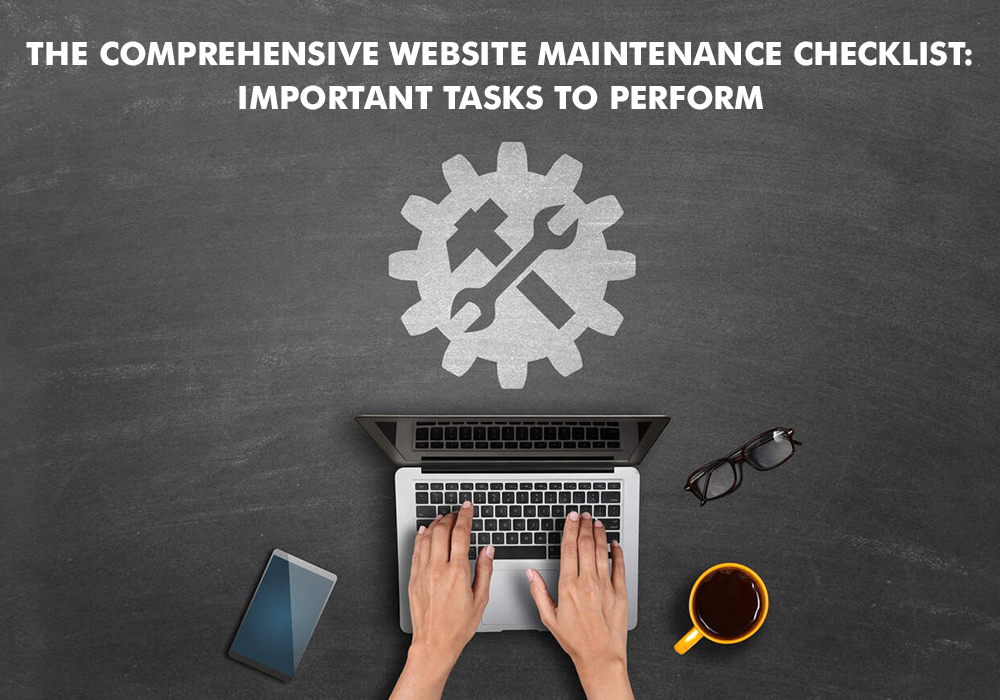
Regular website maintenance helps to present the latest facets of your business to users & also plugs any loopholes in the website from the perspectives of SEO, customer engagement, security & brand image.
Here is how your business can benefit from implementing the weekly, monthly and yearly website health checklists rigorously.
Weekly Website Maintenance Checklist
- Valuable & consistent blog posting:
Regular publishing of valuable content on your website boosts authority building with your audience. Content strategy is important to increase organic traffic & conversions, and should be a priority in your weekly website maintenance checklist
Consistent posting of relevant content tells your audience that you are a subject matter expert. It also allows you more opportunities to use keywords pertaining to SEO.
For instance, your audience might be looking for a digital marketing agency using the keyword ‘best digital marketing company’.
In order to rank for this keyword, you must create blog posts about both the topic digital marketing, as well as your business and how it provides value addition to your customers, strategically embedding relevant keywords in those posts. In this way, you’ll be using the keywords more organically, in ways that read naturally and offer tangible value within the content.
- Checking for & fixing broken links
Next in the list of weekly website tasks is identifying & fixing the broken links.
Websites are storefronts of your business’ online presence. If any links to your website pages are broken, online audience will never arrive at what they are looking for on your website, Google’s web crawlers won’t be able to find and index those pages, leading not only to loss of traffic but also of possible revenue and prospects.
It leads to bad UX and potential clients get the impression that the website is not up to date.
Set up page redirects if content has been relocated to new pages. Correct any typos or spelling errors in the link. For instance, if your ‘products’ page is changed to ‘our products’, do update the link to it as well.
There is no dearth of tools online which you can use to check broken links during website maintenance. A tool like Google Search Console is quite useful here. If you have used a website builder like WordPress, you can use its plugin called Broken Link Checker.
Do maintain a record of all the link changes and keep updating that record.
- Core website backend updation
Do a weekly check on the latest versions of the technologies used to build your website. Regularly patch-up your website with the latest security updates.
After updating your backend – for example, if you’re using WordPress, you must update it to its most recent version, do verify that website’s functionality is still integrated & consistent as it was before the updates were applied.
If you have used a site builder, your website would be using a lot of plugins which keep updating as their developers continue to optimize them. Do update these plugins every week to their latest versions. Plugin updated bring enhancement in features, security and even load performance.
- Ensuring browser compatibility
Not everyone uses the same browser to view your website.
Also, browsers like Chrome, Mozilla Firefox & Internet Explorer keep updating regularly. Such browser updates can affect the look and feel of your website.
It is possible that your website, which looked awesome on Chrome, might look messy on IE or Firefox. A bad first impression will leave you with a lost sale.
You can use online tools to check the compatibility of your website on different browser versions, such as TestComplete. Simply enter your website URL in the tool and within 30 minutes, you will have full report about which browser versions your website needs reworking on.
- Correct working of forms
Forms are important in capturing leads for business. Prospects show their interest in your products/services by submitting enquiry and contact forms.
You must ensure there are no script errors, forms display and submit correctly on both mobile and desktop, confirmation emails (or welcome emails) are sent promptly and correctly to prospects, and if you tend to receive a lot of spam, be sure to add a CAPTCHA as well.
As a test, populate your website forms and submit them to check that the respective set up processes for their submission are working correctly.
A rule of thumb to gauge forms’ effectiveness is that if you are frustrated in negotiating through & submitting your forms, chances are your audience is frustrated too! Keep it simple and precise. Start with as few fields as possible, and based on the quality of enquiries you’re receiving, add more fields to help gauge the veracity and genuineness of prospects.
- Backing up the website
This is one of the most business critical website maintenance tasks. A number of things can potentially go wrong. Your website or hosting backend gets compromised, website updates mess up the functionality or display, or through human error you lose important data.
Automatic backup of website files and information (preferably on Cloud), at least on a weekly basis, is essential to ensure that you never lose data or have to rebuild webpages from scratch (in case of failures or downtime).
Monthly Website Maintenance Checklist
- Reviewing SEO statistics
Analyzing your website’s metrics like the average session time, click through rate, bounce rate, time to load, time on page, goal conversions, exit rate, page per session etc. gives you an idea of how your site is faring online.
These metrics are like a compass to aid you in tuning the business to propel it forward on the right path.
You can use Google Analytics to review your monthly site statistics and identify aspects like:- Which pages or posts got the most hits?
- Why a particular piece of content was more successful than others?
- Where did most of your traffic come from? Web or mobile, social or search, through ads or organically
- Can certain changes on your website make your business more visible among the online crowd?
- How many new users registered on the website?
- What were the conversion rates of your various site objectives?
- Check website speed
Next item on your monthly website maintenance checklist should be checking the site load time.
It is a no brainer that online users don’t want to wait for slow-loading websites. In fact, they expect your site to load within 2 seconds.
You can use Google PageSpeed Insights to check your website’s current load time. It shows speed metrics as described in the picture ahead.
Not just that, it also describes the potential time savings you can achieve after implementing the recommended suggestions on your website.

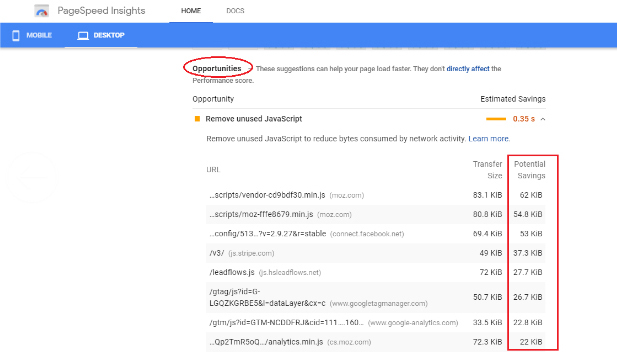
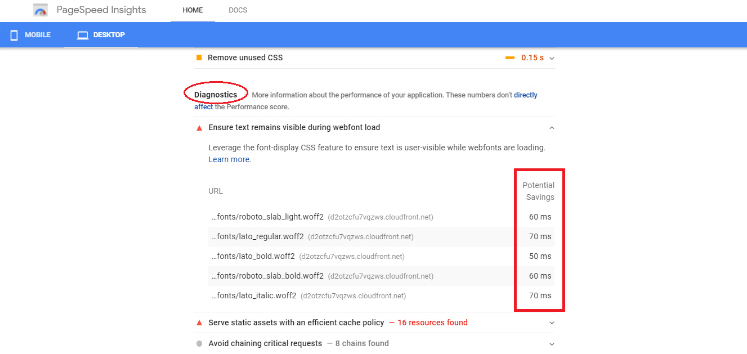
Some of the tips to decrease site load include reducing the redirects, optimized images, limited HTTP requests & enabling browser caching. You can learn in detail how to land a perfect page speed score for your website.
- Update the website copy
Assume you have an e-commerce website selling electronic gadgets. As an extra, your website used to sell smartphone covers as well in the past but it is not so anymore and you have not updated the website copy.
Now, a customer comes along & browses your site for smartphone flip-covers, decides to buy a flip-cover for but later on comes to know that the website is not selling those flip-covers anymore.
The customer would be miffed obviously and you’d witness a missed sale.
Briefly, your website copy must change as your offerings change. This is more difficult to keep track of on larger websites with 1000s of pages. Find & replace and internal website search can help find outdated or irrelevant content.
- Review website security
Cyber threats are evolving rapidly over time. New malwares do rounds over the Internet every month.
Ensure that your website has latest security certificates installed & all loopholes are thoroughly patched.
A good practice would be to go through cyber attacks on other firms in the recent past and testing the resilience of your website against those kind of attacks.
Security scans at least once a month are necessary to identify vulnerabilities in the website architecture.
Yearly Website Maintenance Checklist
- Need of website redesigning
Every once in a while, the website must be fine-tuned to map company’s business goals & vision to the changing needs of its visitors & customers.
Assess whether your current website is:- Able to drive sales growth
- Boosting conversions
- Increasing sign-ups
- Meeting monthly target of leads
- SEO optimized
- Reflecting your brand positioning
- Able to accommodate new products/services
- Adopts the latest HTML/CSS/JavaScript best practices
- If your business is falling short of these goals,
your website might need a redesign
- Renew your website domain … well in time
It is essential that your website domain is renewed well in time. If your domain expires, all services associated with it will be stopped.
This will be a huge setback for your business not only in financial terms but also from the perspective of your website’s users.
Avoid falling prey to such an embarrassing, not to mention expensive, scenario. Adding a domain renewal reminder in your calendar is a simple and effective idea.
- Remove redundant content & pages
Online consumer behavior is highly dynamic. What worked for your business a year ago might not work for your business today.
Your website should present to the visitors latest products/services/values offered by your business. Eliminate the content that is not relevant anymore.
Re-work the website aspects to suit the present business requirements. Remove or redesign the pages which are not up to the expectations of potential customers.
If the pages are relevant but the CTR has become negligible over time, perhaps it is time to publish latest & more relevant content. Refresh the outdated information and update those blogs that are still pulling traffic after a year.
- Keep up with technology
With time, new CMS platforms and coding technologies like Kotlin, React, AJAX, and Django etc. are evolving into new versions.
This necessitates altering/adding/updating website scripts to keep up with compatibility and competition for improved functionality and performance.
- Submitting sitemaps regularly
A sitemap is your website’s table of contents referring to which the search engines determine which pages on your website are important.
It is advisable to upload a new sitemap every time a new page is published on your website or extensive changes are made to the existing pages. Uploading a sitemap yourself by logging into Google Search Console gets your content recognized and indexed faster.
- Update the dates on your website
Often brushed aside as something trivial, not updating the date can have unwanted consequences.
Assume you are a potential customer in need of a digital marketing services provider.
Out of the many options, you select one service provider and visit their website. Their website seems informative & pleasing to the eye until you scroll to the footer which says 2017.
Unsurprisingly, you would be put off instantly, thinking that the service provider is no longer in operation.
This is how many business opportunities are lost due to ignoring of seemingly trivial yet important website aspects.
Adhering to website health checklist keeps your website running in a well-oiled condition.
If you are looking for assistance in ticking off some of the items in your website maintenance checklist, or need help with creating a new list of website tasks, General Data has years of expertise in Web Design & Development in .NET & PHP as well as an in-house dedicated Digital Marketing team to assist you.
We are also proficient in developing Web 2.0 layouts & features, and implementing JavaScript and AJAX to make your website more responsive, relevant and appealing to site visitors.
Do check out our portfolio and feel free to contact us.
Given how 2020 panned out with its after-effects still lingering, websites have become more vital as a marketing tool to keep brands established among their target audiences.
A strong company website clearly communicates everything about its business. It promotes all its current products/services, attracts prospects & ensures customer satisfaction.
Every once in a while, the website must be fine-tuned to map company’s business goals to the changing needs of its visitors & customers.
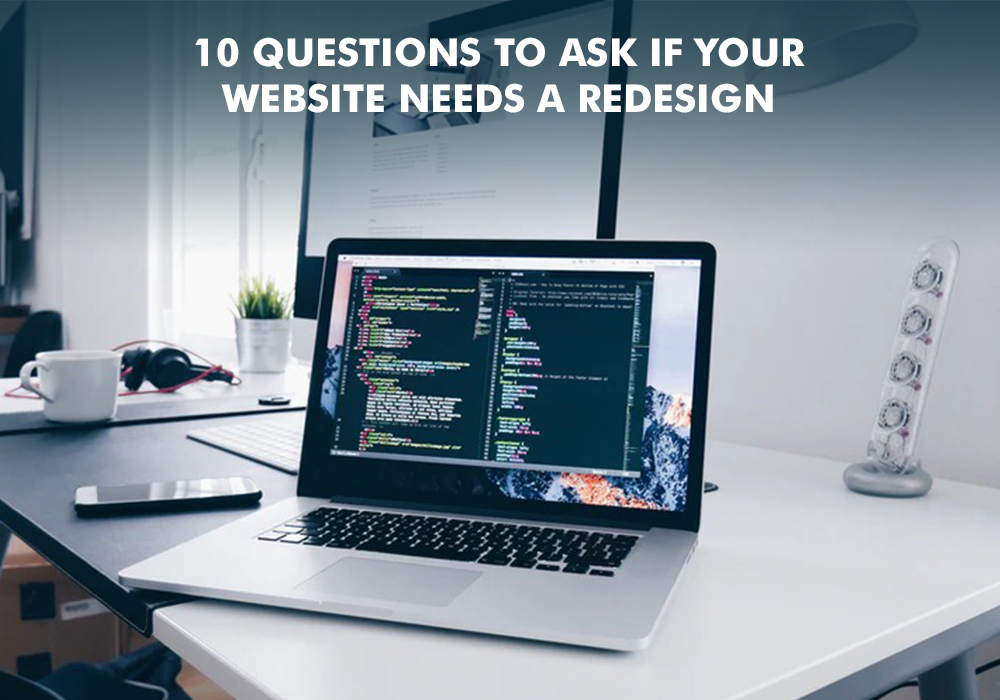
There can be various reasons for redesigning a website such as rebranding, increasing the website traffic, converting leads, enhancing site’s security etc. Even a simple makeover of the website, like changing its color theme, can turn things around in favor of the company.
But before all that, you need to precisely identify why your company website needs an overhaul.
To prime you, here are 10 questions to ask before redesigning a website.
What business goals would be achieved by website redesign?
It is essential to grasp that redesigning a website is both commitment & investment intensive endeavor which can take few weeks to months.
It should solve problems and achieve very specific business goals such as:
- Driving sales growth
- Meet monthly target of leads
- Boost conversions
- Increase sign-ups
- Reduce bounce rates
- Better website navigation
- Integrate new services/products
- Improve security
- Content update
- Strengthen brand positioning
- Addition of new functionalities
Formulate clear cut goals to be achieved through the website redesign and quantify them. It could be “boosting monthly sign-ups by at least 20%” or “raise social network sharing by 40% by year end”.
If you feel your website needs redesign but can’t place your finger on the ‘why’ & ‘how’, the team of experts at General Data, an organization providing web design and development services, will be happy to assist you.
A crisp website redesign questionnaire will help you to clearly grasp what has to be accomplished in the redesigning.
Is your website not truly reflecting your brand and its positioning?
Your website’s content must not only tell the story and purpose of your brand to target audience but also clearly differentiate it from the competitor brands.
As soon as the visitor lands on your website, the brand intent must be clear as daylight to him or her.
For instance, when one lands on the home page of LinkedIn, one immediately gets to know that the website is about job search, building professional connections and learn new skills. Simple, highly effective design.
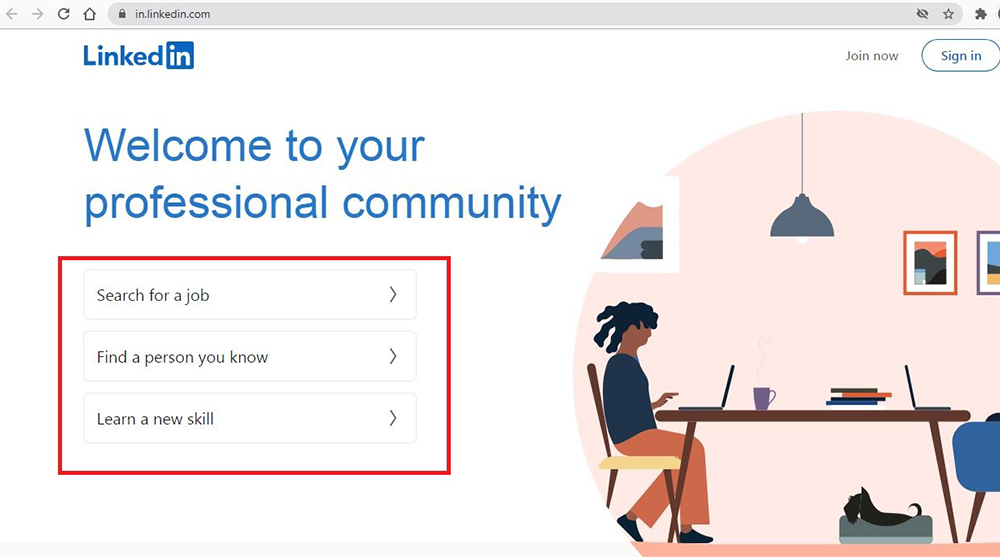
In order to create brand trust and loyalty, your website must imprint the brand’s identity on its digital presence and it should also serve as a point of reference and source of validation for its users and visitors alike.
You must also include case studies and testimonials on the website to enhance the credibility of your business, increase the brand visibility and also tell the brand’s narrative in a more compelling way.
Does your website fall short of maximizing SEO effectively?
Next in the list of website redesign questions is how effective the current SEO strategy is and how it will be imbibed during the redesigning.
- Keyword research is vital to a website’s revamp, more so when it is undergoing re-branding or a new service is being launched. A proper SEO audit should yield insights to build a roadmap to guide you in SEO content creation or updating an already existing content.Scrupulously plan for the keywords that each page will focus on which in turn would help to optimize the headers, on-page content, alt-text etc.
- Identify what have been your website’s top organic landing pages in the recent past and whether there is a page view threshold that suits your business. The pages below the threshold might require repurposing or updating (or removal/redirection, if unavoidable).
- Referring to your business priorities, current page rankings & the keyword roadmap, your website might need new page titles and meta-descriptions which are integral to CTR.
- You’d need to plan for on-page optimizations like including the SEO keywords in the h1 and h2 tags as well as in the alt text and landing pages, whenever applicable.
- Minimized site loading times, enhanced content readability and proper set up of 301 redirects will always be the need of the hour.
- Unless you are using a site hosting service, do recreate your website’s XML sitemap which will enable Google and other search engines to crawl your pages more intelligently as per a hierarchy. Here is how you can create your sitemap.
- Connect Google Search Console and Google Analytics during website redesigning. The Search Console will indicate which keywords are driving the traffic and also monitor site’s overall performance.
These are some of the SEO aspects a website redesign company like General Data stresses upon.
Are you changing your products/services drastically or introducing new ones?
If yes, then get your website redesigned to support the new additions.
For instance, here is what Flipkart’s page looked like in 2007:
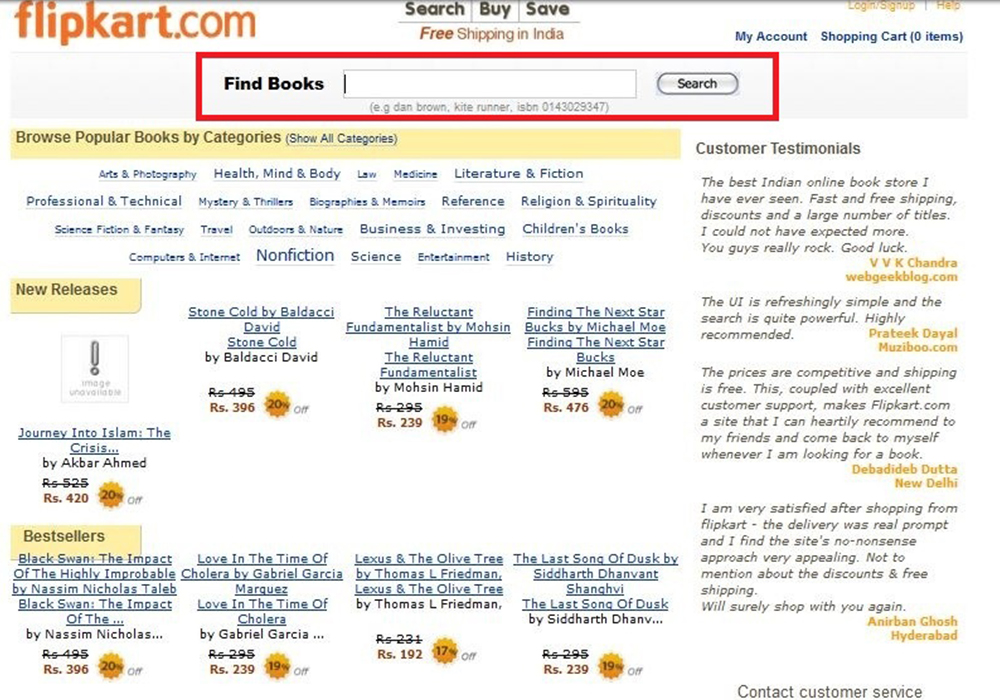 As it is widely known, it started as an e-commerce company for online book sales. Next, they added new categories.
As it is widely known, it started as an e-commerce company for online book sales. Next, they added new categories.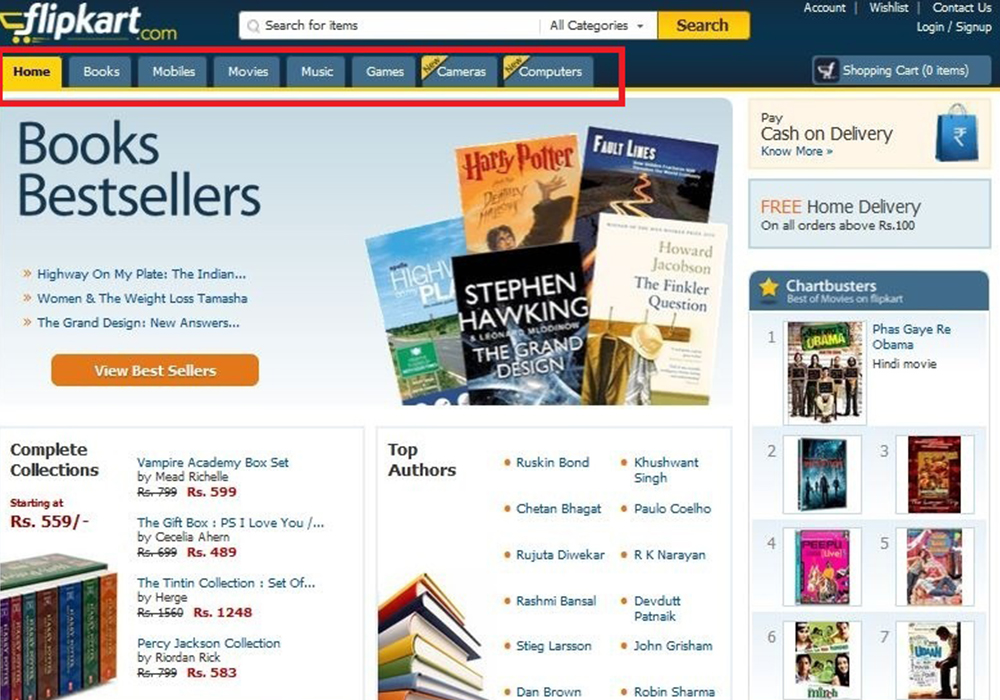
And this is what it looks like today:
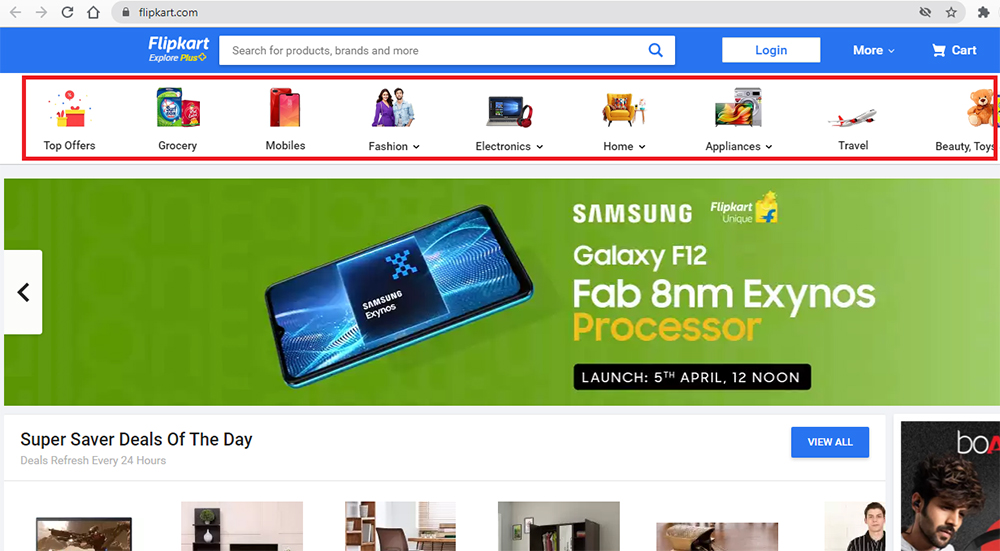
Evidently, the brand architecture significantly affects your online presence. You must keep up with the evolving needs of the customers and accordingly plan the questions to ask before redesigning a website.
Is your website’s content not generating/converting leads?
Use analytics to understand what your website’s visitors are finding valuable on the pages and what they are ignoring. Identify which pages on the website aren’t getting visited as per your expectations.
Your content might be valuable but if the visitors are not able to find it, then it is as good as non-existent and leads won’t be generated.
Even if the content is relevant, a lack of strategic placement of CTA buttons on the web pages further worsens the odds of converting the users into leads.
It is advisable to use tools like Google Analytics or Heat Maps to gain insights about session duration, bounce rate, average time spent on a page etc. This will enlighten those aspects that’ll need special attention during the website redesigning.
The content which is not working at all is expendable and must be either done away with or improved during the redesign.
Can your target audience find what they are looking for?
Your audience will drop-off if they find the website’s content irrelevant or unhelpful. It requires some intuition to gauge your audience’s needs from their online behavior on your website. Identify if the visitors are experiencing a knowledge gap when visiting your current website. It might be the technicality or complexity of the content which puts them off.
If the content presentation to the visitors is below par, they won’t stick around for long. Visual appeal of the information matters. Increased bounce rate will debilitate the website ranking and its position in the SERPs.
Make it a point to include infographics in the revamped website to convey the content’s intent more accurately. People relate with and remember visuals quickly and for longer times. Compelling storytelling through visuals helps retains users and can lead to their conversion.
What are the pain points of your website’s users/visitors?
Typically, the users complain about the following aspects pertaining to the website:
- High site loading times
- Website rendering improperly on mobile devices
- Unreadable or outdated content
- Difficult and confusing navigation
- Sign-up form not working properly
If you are unaware about the users’ pain points, simply ask them using tools like Google Forms as short surveys. If your business has handles on Twitter, Facebook or Instagram, seek your followers’ suggestions in a tweet or post. You can also send a special survey email to your mailing list.
Is website security an issue for you?
With emergence of new web technologies over the years, number and complexity of internet hacks have also grown.
Since July 2018, Chrome has been labelling HTTP sites as insecure for browsing. You risk to lose users if you don’t make the switch from HTTP to HTTPS.
Ensure your website implements secure socket layer (SSL) and is protected with a web application firewall (WAF). You must know web browsers are actively discouraging users from trusting SSL lacking websites.
Has the current website become unmanageable?
Creating a custom solution to a website issue can take many hours which costs money. If your website‘s management at the backend gobbles up too many hours in bug fixing or if the website is not able to efficiently handle the transaction & online traffic load anymore, then do plan for an in-house website audit and redesigning exercise, or seek the assistance of a website redesign company.
What about the website’s mobile responsiveness?
You don’t want your users to drop off from your website in frustration just because it doesn’t respond and adjust to the screen sizes of their devices like tablets, laptops or smartphones.
Google already recommended in 2015 that unresponsive websites would fare poorly in the SERPs as against the sites designed for both mobile & desktop users alike.
If your website is grappling with this, it is a huge green signal for redesigning.
So these were some of the questions to ask before redesigning a website. If your website is hustling with the issues discussed above and you are looking for the assistance of a website redesign company, then look no further. Our team of experts at General Data specializes in customized website redesigning for:
- E-Commerce Websites / Online Stores
- Music and Video Streaming Services websites
- Sites that act as data & information repositories
- Web Applications with holistic UI and UX flows
- Company Profile websites
- Individual / Portfolio Website
We have top-notch web designers & developers with exceptional skills to deliver high quality web design and development services. Our company is also proficient in developing Web 2.0 layouts & features, and implementing JavaScript and AJAX to make your website more responsive and appealing to site visitors. Do check out our portfolio and feel free to contact us.
An organization’s credibility strengthens when the information it provides online is relevant to the search queries of its consumers. Search queries of the users reflect their search intent. Keeping in mind the billions of searches performed on Google per day, a digital marketing agency reinforces a company’s brand & multiplies its marketing success by correctly fathoming users’ search intent (aka keyword intent) and implementing the right SEO strategy to solidify a robust online presence.
Companies strive to optimize search by identifying keyword intent of its users, implementing best search intent optimizations & targeting them with relevant information about its products and services.
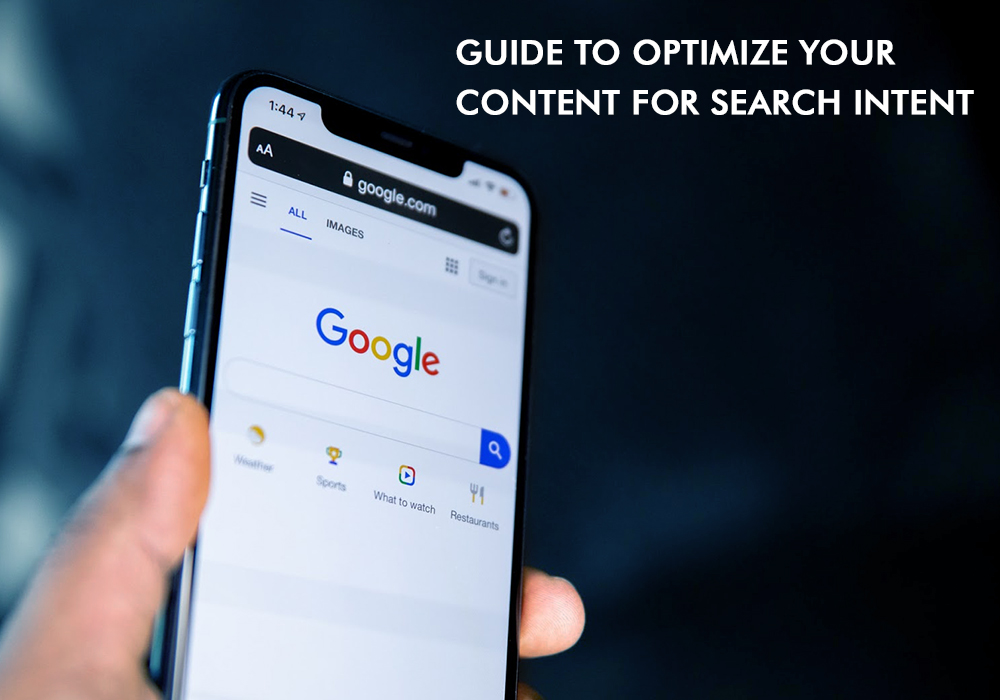
What Is Search Intent?
Search intent, an intangible component of a user’s search, is the ‘expectation’ of the user behind the query. Thus, search engines sift through & process tons of user data to ascertain what the online crowd is thinking or talking about.
Also known as keyword intent, search intent also pertains to the reason which prompts the user to fire a specific online query. It maps to vibes of the consumers about the products and services offered to them.
For instance, a user who has to travel to Mumbai may look up ‘hotels in Mumbai’ in a search engine. A result page which gives the user information about list of hotels, best occupancy rates, customer ratings for hotels, meals & other facilities, discount offers on bookings, nearby sightseeing places, availability of flights to Mumbai etc. has very closely interpreted multiple dimensions to the actual intent of the user – travelling to Mumbai (and not ‘hotels in Mumbai’).
It is no exaggeration that search engines these days have to be a good mind reader, without interacting directly with the other party!
What is the importance of search intent in SEO?
Today, consumers search & decide online on the go. It could be about a product or service or for entertainment. Search engines have evolved over the years with improved algorithms for determining users’ search intent. Google is smart to rank pages not just on the basis of the search term but also as per the intent behind it. This necessitates that your post or page should fit the search intent of your audience.
A user looking for ‘strawberry jam’ on Google is not interested in its historical relevance. The intent of the user here can be:
- Finding recipe to make strawberry jam
- Where to buy strawberry jam around user’s location
That’s why the content your page provides should be able to capture the implied, intangible underlying query.
Merely focusing on integrating the keywords into your content is insufficient. The focus of search optimizing has to be shifted from merely providing information to defining users’ experience.
Search engines take into account signals like load speeds, backlinks and many others to determine if a web page answers the user’s query as ideally as possible. The faster users’ queries (both explicit & implicit) are answered to their satisfaction, the better the odds of their sticking around your content.
General Data, one of the best SEO companies, implements search intent optimization for targeting your customers with the best results that satisfy their immediate needs. If you can precisely gauge the hidden WHY/HOW in your customers’ searches, you can unlock a plethora of optimization strategies for satisfying their intents. Search intent optimization enhances the experience of users browsing through your content, aids in retaining them on your page & draws leads to your site. All this significantly contributes to expand your brand awareness.
What Are The Types Of Search Intent?
- Informational Intent
A significant chunk of the online searches have informational intent. People could be looking for information about, say, weather in a city. A search query ‘weather in Mumbai’ gives a result as shown ahead.

Some of the sample keywords of informational queries are:
- ‘what is/was/are’
- ‘how to’
- ‘where is/was/are’ etc.
Users firing informational queries in the search engines have the primary motive of getting factual, clear & concise data.
Signals of informational search intent are visuals (like images & video carousels), ‘People also ask’ (at the bottom in the above picture), rich snippets etc. Google’s understanding of intent goes far. If you look-up ‘guacamole’ on Google, it understands that the user is looking for its recipes and would display videos links for the same.
- Navigational Intent
Searches of this type are conducted by those users who already have a specific company or product/service in mind. They only need help getting to a particular website. The results to their queries often have the brand knowledge panel, also known as the Authoritative OneBox.
Say, a user looks up ‘YouTube’ on Google & get shown the following result.

The result contains site links the user can navigate to & also the rating it has on the Play Store. The panel on the right hand side shows brand information like its logo, CEO, founded, parent organization, revenue, founders etc. It mentions that YouTube is a video sharing company. It also has ‘Films produced’ section on the panel.
The snippet under the heading ‘People also ask’ has other related informational content to which the user might intend to navigate. It will immensely benefit to learn how to add rich snippets to your pages with schema markup.
Google understands that no matter how generic the search keyword ‘YouTube’ might be, the results have always to be skewed towards the brand YouTube to broadly accommodate the search intent.
- Transactional Intent
If a user is browsing the web for buying stuff, the underlying intent is transactional. The aim here is to complete an action, like downloading a software, purchasing a product or hiring a content writer etc. The keywords for a search with transactional intent can be:
- ‘buy’
- ‘best offer for’
- ‘discount on’
- product name etc.
Some of the signals of transactional intent are product carousel, brand carousel etc. in the results. For instance, looking up for ‘best gaming laptop’ on Google fetches the following result.

It displays the prices, ratings etc. of gaming laptops that are most commonly bought online, in addition to the list of various brands.
Optimize Your Content For Search Intent
Identifying the most dominant intent for a search term is tricky. It requires a lot of brainstorming and planning to grasp the underlying intent in a search query & ensuring the landing page fits it.
As an example, looking up the keyword ‘salt’ on Google may have different underlying intents for different people. For the general mass, it would be the common salt; for chemistry teachers, it would be the salts related to acids and bases.
Take it a step further and you’d get a famous movie of that name in the results if you’re a Hollywood movie buff! But since the word ‘salt’ is most commonly associated with the common salt so that becomes the dominant intent which tops the SERP in the end.
It is a great skill to be able to separate the intent (both implicit & explicit) from the queries & visualize it from every perspective. For instance, an explicit query like ‘the best SEO agency in Mumbai’ implicitly asks for information like location, review, photos etc. It takes some insight to draw out the intent like that hidden behind the query.
As a business owner, you have to map the intent conveyed by your content to the implied user intent. Think about the different ways the audience may query the search engine pertaining to what you are presenting to them in your content.
The verbiage, length of the query, limitations of your product, cultural/linguistic/religion background of the audience, tools used by users to access the search engine (e.g. laptop, desktop, smartphone etc.) – all these considerations help you to better map the user queries to the respective answers in your web page.
It is advised not to stick to search optimizing from the perspective of just one search engine. Optimize search for other engines as well. If you are optimizing only for Google, you are losing out the traffic searching content on Bing & Yahoo. Optimizing as per other engines will give you a broad insight about the overall audience’s intent with respect to the content you are going to publish on your website.
Be a step ahead of your users. Anticipate what they will search for in the near future and thus drive your content to them accordingly. Keep an eye on the current & upcoming trends.
Next, it won’t make sense to show your audience a products page when all they are looking for is informational content.
This holds true the other way round as well. If a user wants to buy your product/service, don’t keep him tangled in long articles; lead him directly to your products page. It is a good idea to optimize your products page with commercial driven keywords.
For example, if your website sells gym equipment, you can optimize a page for the same (e.g. buy gym equipment). What’s more, you could have a blog on ‘how to properly handle gym equipment’, or ‘HIIT exercises at home’ etc.
To make the content intent friendly, use an SERP checker to analyze the keywords you are going to optimize the content for. Identify the type of intent which is most dominant. Is it the informational intent or the transactional one? What are the related searches? Which images are coming up on the results pages for the chosen keywords? Align your content in line with what you observed in the SERP checker. Strive to match the intent as much as possible. If you find that the intent in the results page is highly divergent from the content you wish to publish, readjust your strategy taking different but related keywords.
The other important aspect of a successful content is its CTA (call to action) effectiveness. It could be administering a survey to the audience for feedback about a product or asking them to register on the website for getting discounts on future products purchases. Proper in-content CTA can help in conversion. Some of the action words for creating in-content CTA are categorized ahead:
- Sense of urgency: ‘Today only’, ‘Hurry!’, ‘Last day!’, ‘Order now’, ‘Ending today’ etc.
- Emotional: ‘Let’s do it’, ‘Party now’, ‘Here’s the secret’, ‘See for yourself’ etc.
- Sense of belongingness: ‘Join the community’, ‘Be a part of’ etc.
- Instructional: ‘Register’, ‘Subscribe’, ‘Click here’ etc.
- Power words: ‘Guaranteed’, ‘Now’, ‘Free today’ etc.
Location is another aspect you need to factor into before publishing the content on your page. Search results vary from location to location as IP addresses are used by engines to customize search results. It implies that your website may rank highly in some locations as compared to the others. It could also rank low. Also, the search history of the user directly affects his/her search experience. This calls for an extensive research about the extent of mapping that needs to be done between your content’s conveyed intent & the users’ intent.
Bear in mind that the faster, & more consistently, your content resolves users’ queries, the surer you can be of them scrolling your content all the way down. Strive to present your content into bite-sized pieces. If your content is providing a solution to some problem, make sure the steps to do so are clear & concise. The keywords you place in the URL, headings and metadata will decide how close your content will be to audience’s intent.
Use conversion rate optimization tools to gain insights about user experience. If you think your page might not map with the implicit query in users’ search despite all the measures you have taken, facilitate your users with FAQs. It is an open secret that informative content hidden behind a login requirement chases the audience away. Do away with it, if possible. Keep things simple, transparent & valuable.
Is Your Website Optimized For Search Intent?
Now that you’re aware how vital it is to optimize your web pages for matching your users’ search intent, it is high time that you implement the best search intent optimization practices. The team of experts at General Data, an SEO and digital marketing agency, can help you with connecting your content with your audience’s search intent in the best way. We can assist you to capture the segment of online traffic which you have been losing hitherto for the lack of implementation of accurate search intent optimizations. Customer behavior is forever changing & our in-depth SEO audit & audience analysis can help you keep ahead of them. Feel free to reach out to us at GDATA.
Page speed for a website refers to the speed at which a web page loads in the browser.
It can be defined in terms of either the ‘page load time’, which is the time taken by a page to fully display its content, or though ratings. For example, Google PageSpeed Insights rates mobile and desktop load speed on a scale of 1-100. A crucial component of load speed is the ‘time to first byte’ (TTFB) which is the time taken by your web browser to receive the first byte of information from the server.
A web page with load time of 0 to 3 seconds has more potential to be ranked higher by search engines, as compared to a page with greater load times.
With load times of 4 seconds or more, the bounce rate has been observed to increase significantly, as does pogo-sticking – which refers to when users go back to search results and move on to the next website. User attention spans are low, they expect very quick load times, which makes taking this into consideration extremely important. Increased user engagement contributes to higher conversion rates and thus the need for a fast website. Thus, the best digital marketing agencies always keep these aspects in focus while performing search engine optimization.
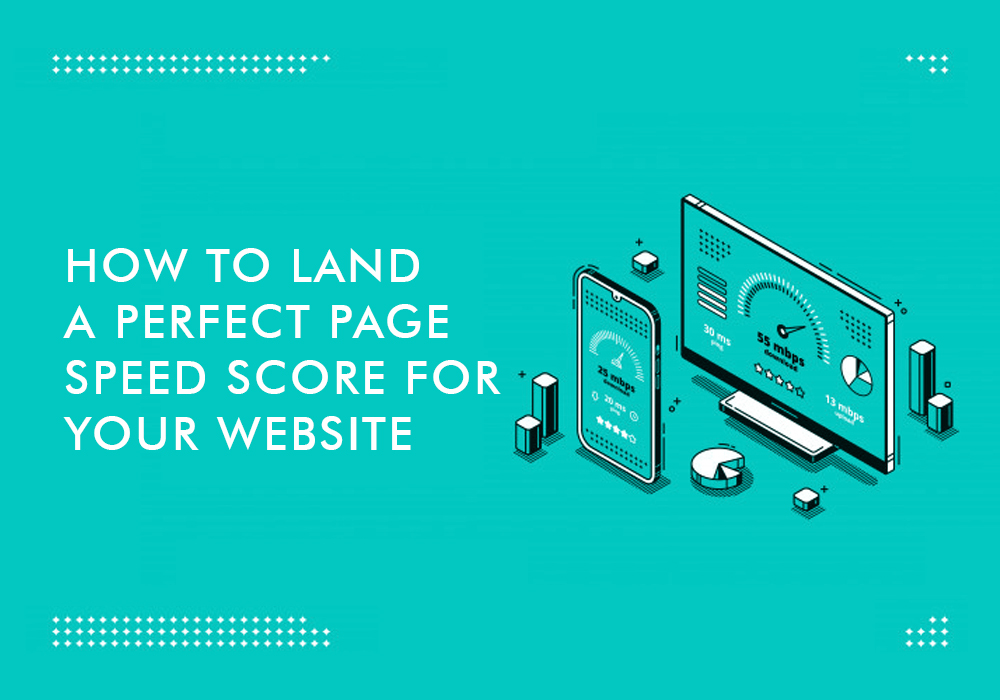
Why Does Page Speed Matter
Page speed is a critical measure of the quality of a user's experience. It directly affects user engagement and how likely a user will return to your site. It is a key component of the Core Web Vitals in performing SEO related activities.
If your web page takes too long to load, the users will not only leave quickly but they will remember it as an undesirable experience and thus may never click your website’s link again. It is no surprise Google announced a long time ago that a website’s speed would be a critical factor in search ranking algorithms.
The position at which your website’s link shows up on the SERP affects the click-through rate, and vice versa. As a general rule, top 10 search results fetch majority of the clicks with top 3 results capturing the biggest chunk of those clicks. Higher user engagement with your website will make your website appear more relevant to the search engines thereby increasing your website’s chances to rank even higher.
In a year-long effort towards performance redesign of web pages of Shopzilla, a 5 second speed up (from around 7 seconds to around 2 seconds) was measured which in turn resulted in a 25% increase in page views & a 7-12% increase in revenue – clear indicators of the importance of good page load speed.
Tips to Optimize Pages for Perfect Load Speeds
So how does one increase the website page’s load speed?
Common setbacks to page load speed are:
- Large image file sizes
- Unoptimized HTML, CSS and JavaScript coding
- Unnecessary or unoptimized plugins
Here are some tips on how to improve your page speed performance.
- Compressing & optimizing images:
Make sure your images are in the correct format & compressed for web use. If you can avoid using images by using CSS instead, do it.
For displaying graphics having less than 16 colors, PNG format is suitable while for photographs, the JPEG format is more apt.
Image compression and proper format can save up to 50% or more on image sizes which in turn increases website speed.
You can do this using tools like Photoshop which have compression features, in addition to tons of online tools.
- Minifying the code:
Minifying condenses code without impacting browser processing. Remove unnecessary spaces, commas, comments, formatting & characters and do away with unused HTML, CSS & JavaScript code. Shorten it as much as possible. Google’s PageSpeed Insights recommends this.
CSS files - which can have hundreds to tens of thousands of lines of code - are often overlooked. Minifying CSS yields 20-30% savings in size. Minifying the JavaScript files also empties a lot of space. All of this significantly contributes to increased speed.
- Accelerated Mobile Pages (or AMPs):
AMP is a Google project that serves mobile optimized web pages when mobile browsing is detected.
Since AMPs don’t have too much formatting, they are quickly loaded into the browser & speedily deliver the content to the user.
AMP allows only asynchronous JavaScript to forbid JavaScript from delaying page rendering. It uncouples document layout from resource layout i.e. it can load the layout of the page without waiting for any resources to download.
- Minimizing page redirects:
Whenever a user is redirected to another domain or URL for results, the user is forced to spend additional time waiting for the result to get fetched & rendered.
This extra HTTP request-response cycle slows down the page speed.
Make sure redirects happen only when absolutely necessary.
- Capitalize on browser caching:
Whenever information (or results) are rendered on the web page against a user‘s query, the browser caches the results so that minimum time is expended in reloading that result page to the user or if the user returns to it sometime later.
- Periodic monitoring & tweaking:
Always be on a lookout for trying new tools & workarounds to further speed up the page loading of your website.
It should be a continuous effort so as to furnish best results to the users in no time thereby increasing the chances of conversion.
Conduct frequent website speed tests for both mobile and desktop (as discussed ahead) so you can gauge the effects of your optimization activities. The more you understand the impacts of each tangible activity on your scores, the better you can develop your website going forward.
How to Diagnose Page Speed for Mobile?
You can use the free Google tool Test My Site to assess your website’s performance on mobile. The tool uses data from Lighthouse (open-source automated tool for improving quality of web pages) to recommend improvements to your page’s speed & site’s speed.
As per the tool, if you are calculating your page speed, the speed categories defined by FCP data are as follows:
Good: 0-1 second
Needs Improvement: 1 second-2.5 seconds
Poor: 2.5 seconds and up
As an example, let us see how SEO speed test is performed for a website for mobile platform.
On Test My Site tool’s page, enter the URL of the website you wish to diagnose in the text field (as highlighted in the picture below) & then click on the adjacent arrow to begin assessing the website for mobile.
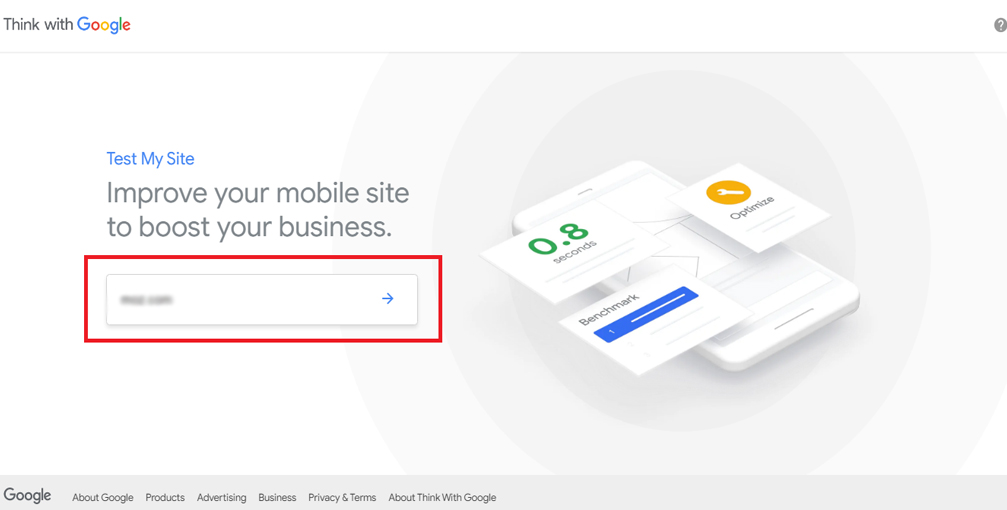
After some time, the tool will reveal the details of its assessment of the website. As you can see below, it has given a ‘Good’ rating to the page speed of the website as it loaded within 2.5 seconds.
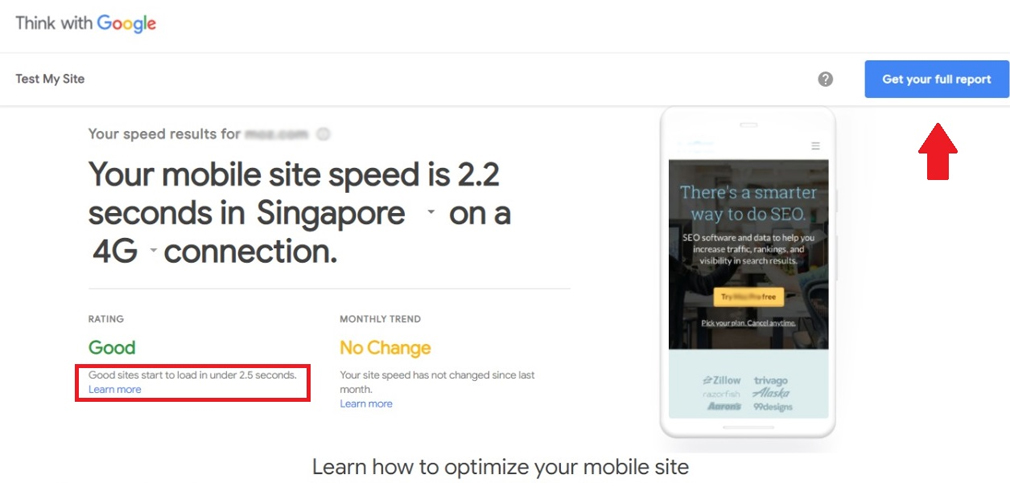
Next, click on ‘Get your full report’ button at the top right hand corner which opens a form where we provide an email address to receive the full report.
Post that, we get an email containing the assessment report with recommendations to improve the mobile experience of the website.
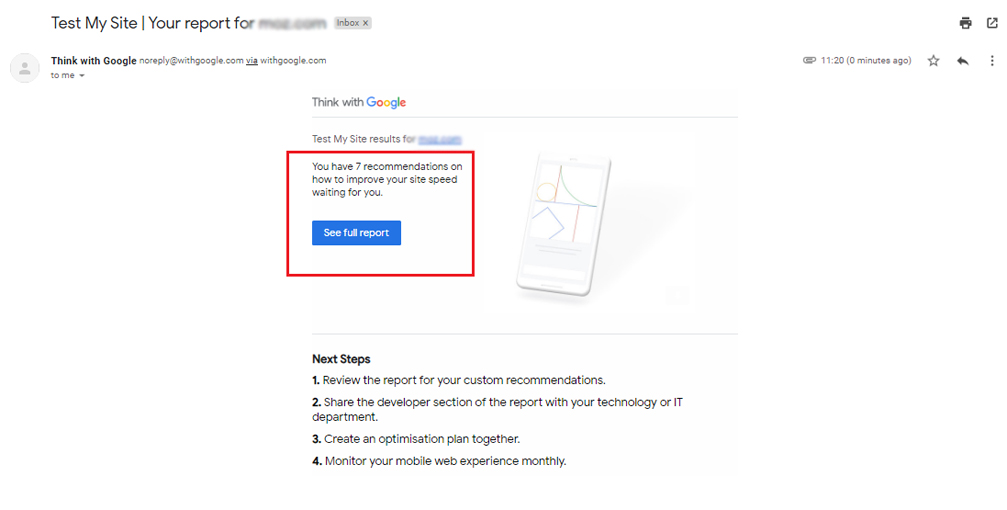
Click on ‘See full report’ button as displayed in the above picture. The full report gets opened in a new tab from where it can be downloaded.
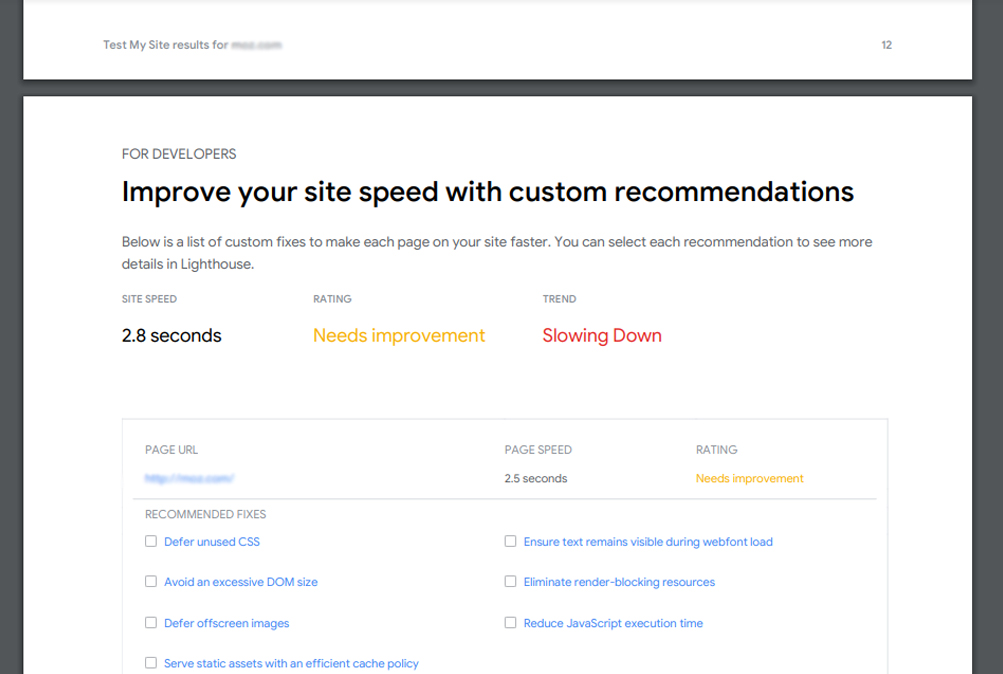
In the report, there are tech-specific fixes recommended for developers to further improve the overall mobile speed & experience.
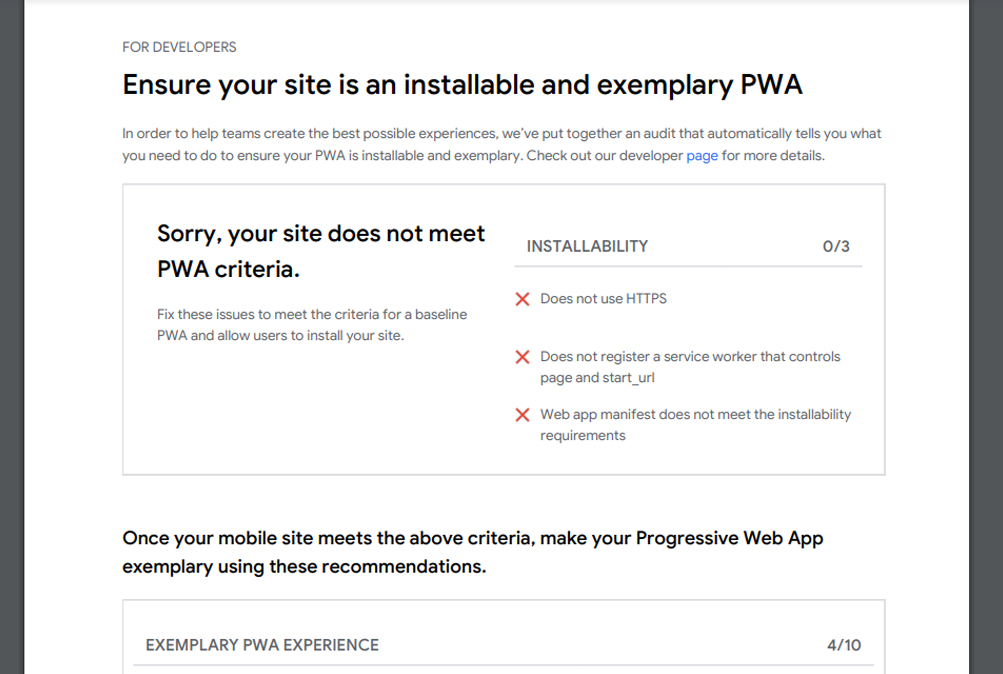
Evidently, there are some PWA (Progressive Web App) criteria which the site needs to fulfil. Recommendations for the same are mentioned on the next page of the report as shown below.
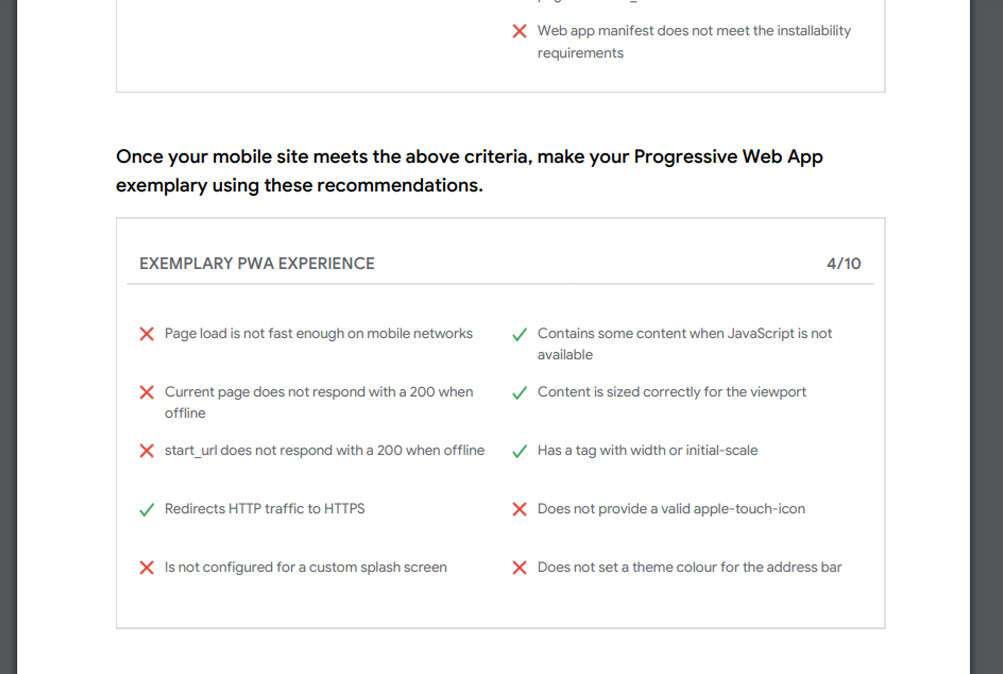
There are various plugins which can be used to optimize page load speed. However, care has to be taken to maintain a balance between overloading the site with plugins and site’s performance. Too many plugins hinder the website’s speed.
Additionally, we can view the performance characteristics of the website in Chrome DevTools.
Open the website in a new tab in Chrome browser on desktop.
Press Ctrl+Shift+I to open the ‘Performance’ tab of DevTools. Then, press Ctrl+Shift+E to record the page load.
We get the following result.
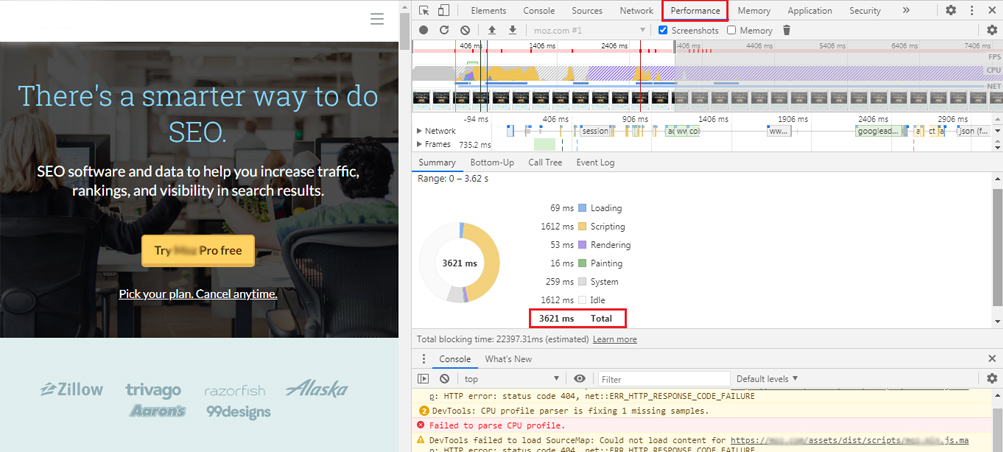
We observe that it took 3.62 seconds (which can vary) for the home page of our test website to load fully.
Next, ‘Products’ page took 2.7 seconds to load as evident in the following snapshot of the run.
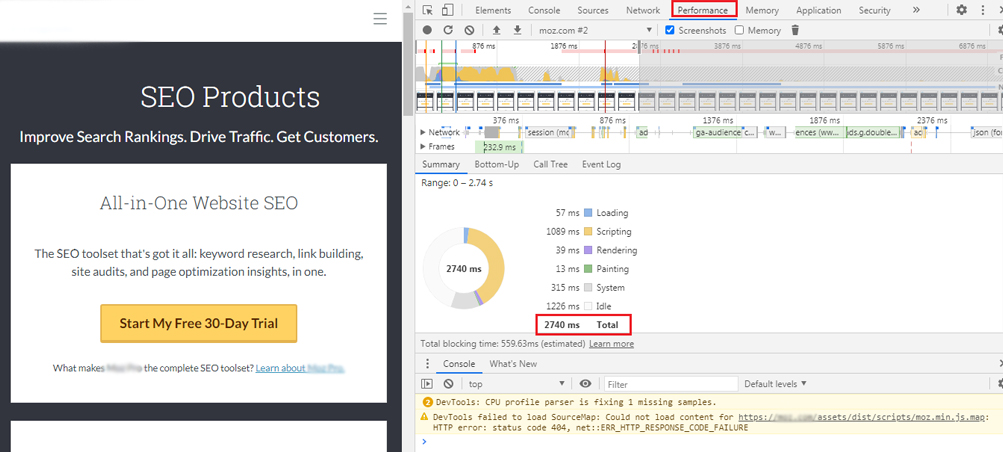
How to Diagnose Page Speed for Desktop?
You can diagnose the website for desktop in the commonly used Google’s PageSpeed Insights (PSI) tool. PSI provides performance reports (and suggestions for improvement) of a page on both mobile and desktop devices.
We will continue with our example of our test website discussed above. We open PSI in a browser tab.
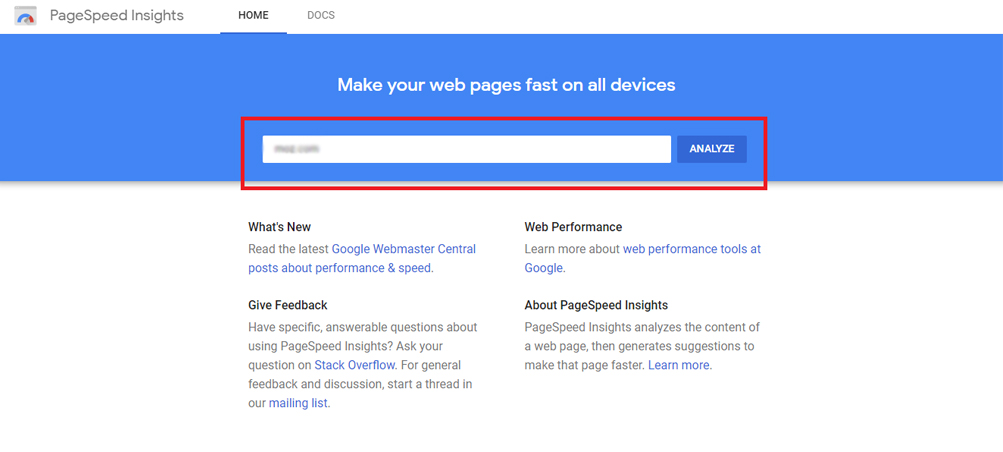
We enter website’s URL in the text field and click on the ‘Analyze’ button (as highlighted in above picture).
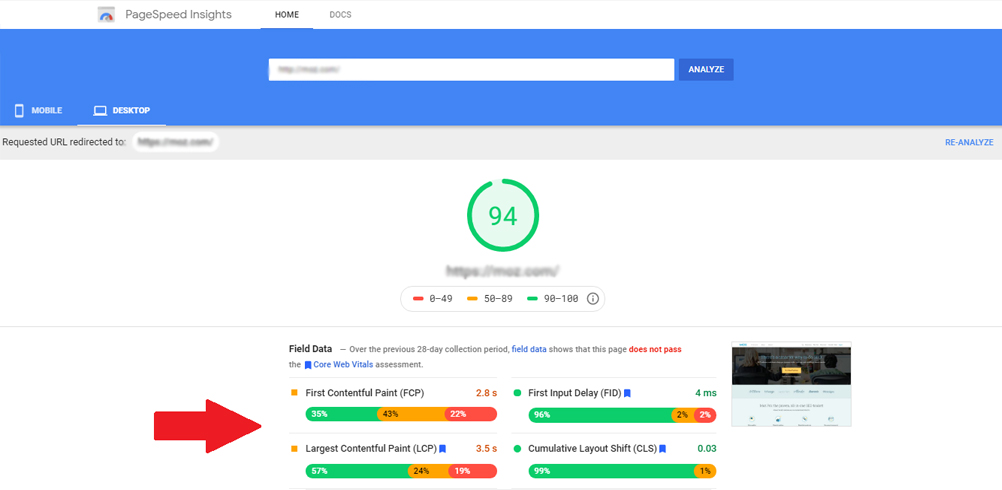
Since we have already discussed mobile assessment of website, we click on ‘Desktop’ tab at the top left hand corner of the page.
As shown above with highlighted arrow, a page containing the performance score of the website is displayed along with other metrics in Lab Data section.
The performance score of 94% means website is doing ‘good’ at the moment. The score is determined by running Lighthouse to collect and analyze data about the page. The score is categorized as follows:
- Good: 90-100% score
- Needs improvement: 50-90% score
- Poor: below 50% score
Scroll down the performance result page. Lighthouse separates the audit of a website in PSI into the following sections:
- Opportunities: suggestions about how to improve page’s performance metrics & estimations of page load speed if those suggestions are implemented.
- Diagnostics: gives additional information about how a web page compares to best practices for web development.
There is a ‘Passed Audit’ section as well but our concern here will be the above two sections.
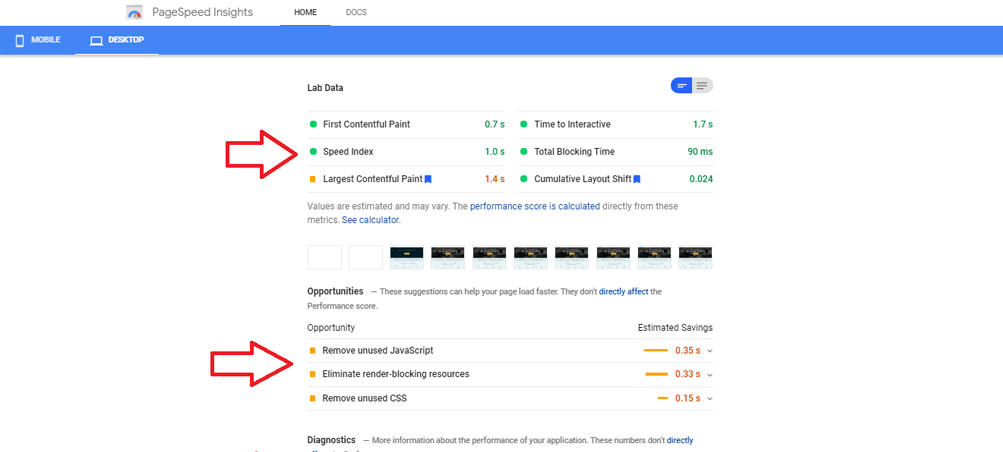
In the snapshot above, we observe that there is still an opportunity to speed up the page loading by around 1.8 seconds.
The next two pictures drill-down into ‘Opportunities’ and ‘Diagnostics’ sections, respectively, depicting the potential savings of seconds that can add to the faster page loading.
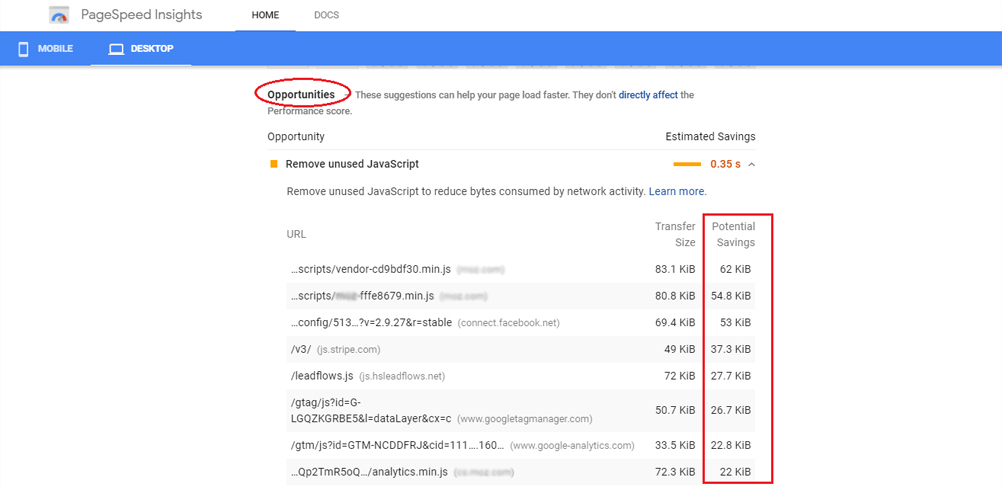
Opportunities
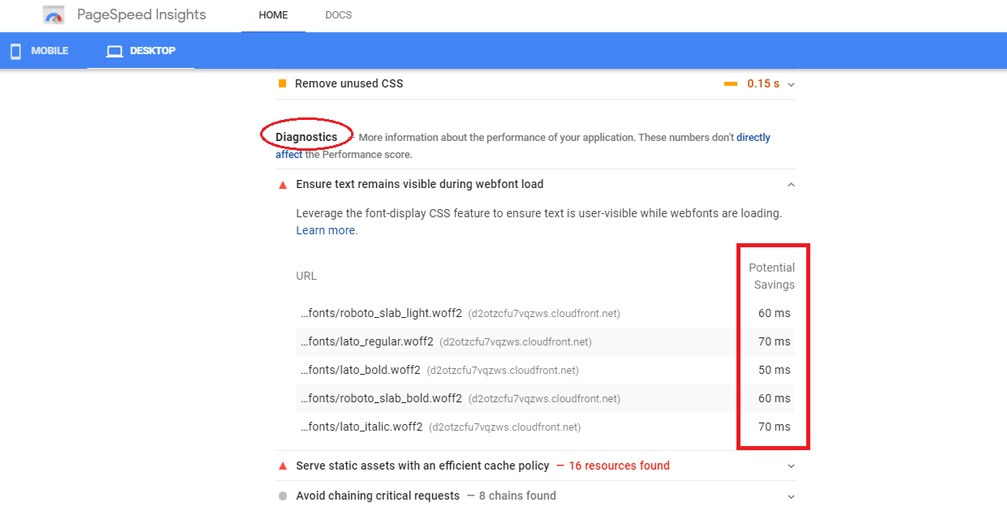
Diagnostics
So, that was all about the importance of a high page speed and how to test your website’s performance on mobile as well as desktop.
The team of experts at General Data understands the significance & implications of page load speeds vis-à-vis SEO.
We help you identify not only the hurdles that slow down your website but also actively implement smart measures and tweaks to remove them & improve website loading speed, using best-in-the-industry tools and religiously following SEO best practices.
For a no-obligation pre-SEO audit of your website, reach out to us here.
Even today, around 90% of all corporate information resides on paper. Operating and maintaining a paper based filing system is quite common in real estate firms, law firms, medical practices and lending companies.
Law firms, for instance, are inundated with piles of physical files about clients’ cases. As every case progresses, tracking becomes difficult and paper keeps unnecessarily building up.

Magnitude of the Problem
According to research by PricewaterhouseCoopers:
- 90% of all the pages handled each day in the average office merely get shuffled without deriving significant business insights.
- Companies spend $20 to file a document, $120 in labor to find a misfiled document & $220 in labor to reproduce a lost document.
- 7.5% of all paper documents get lost and 3% of the remainder are misfiled.
For a considerable amount of time, workers are left looking for the information they need to deliver their output.
As per the findings of McKinsey Global Institute, 19% of the workweek is spent by workers in searching for and gathering information.
Role of Document Scanning for Enterprise Level Business
Managing the sheer volume of documentation in paper format is not just time-consuming but also, unfortunately, error prone.
Most importantly, it is the expensive corporate space that is redundantly occupied by physical files and cabinets.
Document scanning services are a full suite of functionalities that convert paper-based records to electronic formats which can be specifically indexed and then stored in a structured document management system.
In simple terms, it turns your paper piles into fluid & dynamic archives.
Enterprise document scanning not just supplements a content management solution but it can also be used independently of other business processes if needed.
For instance, banks receive a substantial number of paper-based loan applications. These applications can be converted to digital files and stored centrally.
Additionally, an AI system can determine the creditworthiness of an applicant by processing the information contained in the digitized application.
According to Gartner, a majority of the cost and value around paper documents is the onboarding and servicing of client accounts.
Digitizing these paper documents yields benefits such as client retention, quick time to value, improved profitability etc. Unlike earlier, customer journeys which began on paper now begin on a web or mobile app.
7 Benefits of Document Scanning for Your Business
Here are seven core benefits that a document scanning service can render to your business:
- Information persistence & disaster recovery
Information loss owing to a disaster is the biggest threat any business faces. According to Gartner Inc., 2 out of 5 organizations that experience major data or records loss due to a natural or man-made calamity go out of business within 5 years.
Companies that have stored electronic backups of their paper records off site, have higher likelihood of organizational survival in the eventuality of any disaster, making document digitzation essential in disaster recovery (DR).
Such companies can have their documents restored from backup copies within a few hours and resume operations. Once a document is digitized and stored centrally, it can never be lost, provided it’s hosted on a safe and secure system.
- Document retrieval
Storing digital formats of physical files makes it effortless to search & retrieve them within seconds from your device, irrespective of your location in the world, via an internet connection.
Even archived digitized files containing years of historical data can be readily made available on an ad-hoc basis.
You can access not only key index information but also practically lookup every word on every page of the entire document repository.
- Version control
Do you recall the example of law firms that we stated at the beginning?
As the cases progress, the associated paperwork keeps changing & growing. Tracking those changes manually over months and years is daunting to say the least.Digitally scanning those case papers compresses hours of manual tracking into a few seconds of clicking.
You can even tally the changes pertaining to many cases side by side, version by version.
- Document collaboration
Physical file management systems don’t allow simultaneous sharing of a file by multiple users. The only way is to create physical copies, which results in unnecessary expenditure and decentralized editing. Digitization of documents vanquishes this issue.
Users can collaborate to process the digitized information, share updates with few clicks & resolve issues rapidly.
If one user flags some content in the digitized file, others get notified of it promptly. No one has to leave his/her desk to seek an explanation from a colleague about a file.
- Reduced filing times & storage space
Earlier, document filing used to take anywhere from hours to even days owing to the manual filing process.
Now, once a physical document is digitized and indexed, filing becomes a cakewalk.
Also, the floor space occupied by huge cabinets is vacated for other productive usage when physical files are stored digitally. Roughly 20000 pages of information can be stored per GB and a 50GB hard drive costs under $50. Talk about cost efficiency!
- Security & restricted access
Information security can’t be emphasized enough. Digital storage of physical files through a document management system allows administrator to grant privileges to specific sets of users, from anywhere with an internet connection. Access rights management – read/write/edit permissions - augments security (at multiple levels) of the digitized information.
Additionally, every access to a document, in fact every digital footstep of a user, can be traced easily – a silent sentinel for preventing any data security breach.
- Document delivery
There were times when mailing physical documents took days. On the other hand, a digitized document can be printed, faxed or emailed to anyone within seconds, in any part of the world, without any loss of quality (as opposed to faxing).
The document management system offered by General Data can modernize & digitize your digital ecosystem. Our enterprise document scanning service can digitize your paper documents in hassle-free way.
You can scan your paper documents and send them to us. From there, we will accurately digitize those scanned copies with Optical Character Recognition & then migrate the digitized documents to a secure Cloud storage. Our document management system empowers you with version controlling, simple workflow designing, LDAP & DBMS integration & many other features.
For more information on how we are enabling organizations to transform their documents handling & processing, feel free to reach out to us.
Schema.org – a collaboration between Google, Microsoft, Yahoo and Yandex – allows websites to correctly create and maintain structured data, which helps search engines contextualize their content better and serve this content in more meaningful ways as part of search results. Rich schema can lead to significant increases in click-throughs and conversions when included as a part of your website’s SEO efforts.
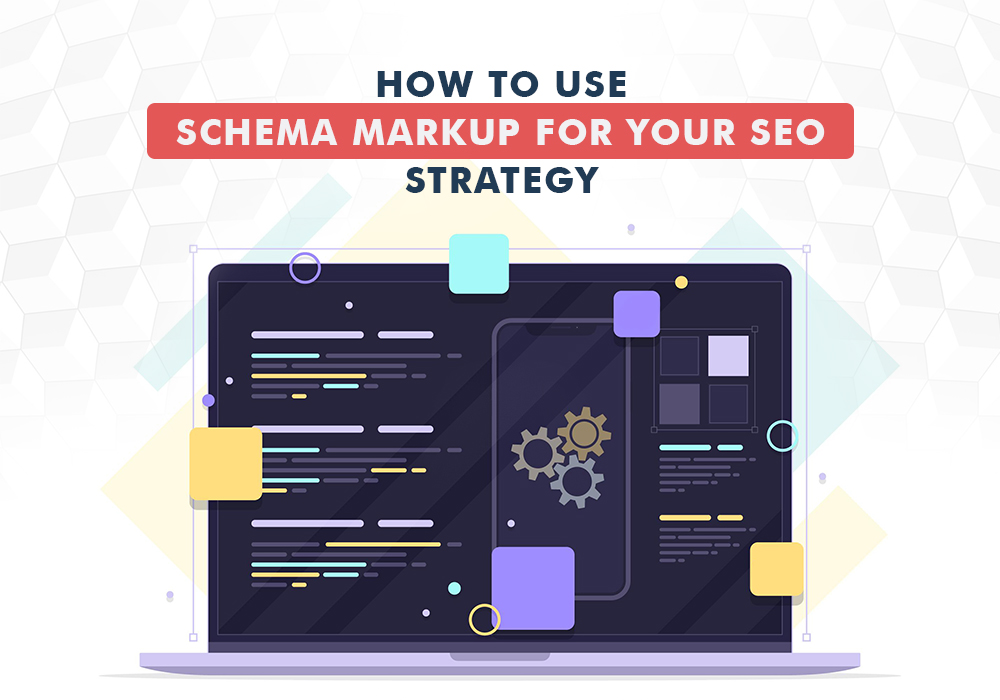
The best SEO companies effectively use rich snippets aka schema markups to make website pages easily stand out in Search Engine Ranking Positions (SERPs).
What is Schema Markup in SEO?
Conventional HTML scripts help search engines only identify what your content ‘says’ and not what that content ‘means’.
Schema vocabulary includes encodings like RDFa, Microdata and JSOD which can be embeded in your web page’s code to make it easier for search engines, to crawl, organize and effectively display your content to users. It helps improve CTR and is a potent search engine ranking signal.
For instance, assume that a user is searching for hotels in Mumbai on Google.

The above result is not very informative for the user as it has no markup applied.
On the other hand, consider the following result, which has proper schema markup applied on its web page.

The above search result has more context and provides essential details to the user at a glance, highly increasing the chances a user will click-through(improving the CTR). Applying the schema markup tells the search engine to display to the user the ratings, reviews & price range of the hotel as meaningful parts to the result. These details are exceptionally helpful to the user.
Applying a markup type to your web page gets it indexed and returned in search results in a very different way.
Suppose there is a web page about Apple Inc. with the words “Tim Cook”. The SERP will just create an entry for “Tim Cook”. However, if the proper markup has been applied to the page, the search engine gets to know that “Tim Cook” is the CEO of Apple and it displays his name in search result as “Tim Cook: Chief Executive Officer of Apple”, which is more relevant to the user.
How to Use Schema Markup on Your Site?
So, how do we actually add rich snippets to website pages?
With the goal to do better in SERPs & also clearly convey your content to searchers, follow these steps to implement schema markup on your website.
- Open Google Structured Data Markup Helper. It will display various data types, in addition to the URL and HTML bar below those types.
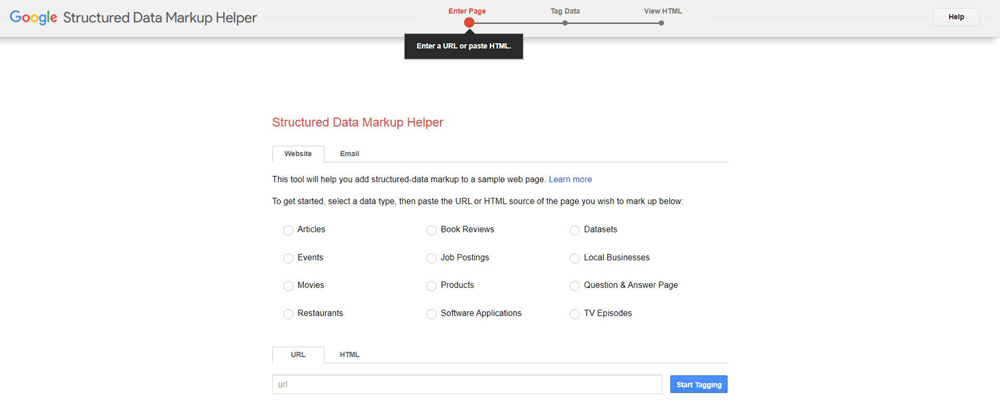
- Select the relevant data type and then paste the URL of your website’s page that you wish to markup in the URL bar.
- Click the ‘Start Tagging’ button adjacent to the URL/HTML bar. This will load the markup tool & also provide you with the workspace where your web page will be displayed in the LHS pane & data items in the RHS pane (see image for the next point).
- For example’s sake, say, your web page has an ‘article’ content type in the LHS pane. Select your article’s title. A tooltip will appear with some fields or data items. Selecting ‘Name’ from the tooltip adds the title of the article as ‘Name’ data item in the RHS pane. Similarly, select article writer’s name in LHS pane and then, from the tooltip which pops up, select the data item ‘Author’. The writer’s name will get added as ‘Author’ in the RHS pane (refer picture as shown below).
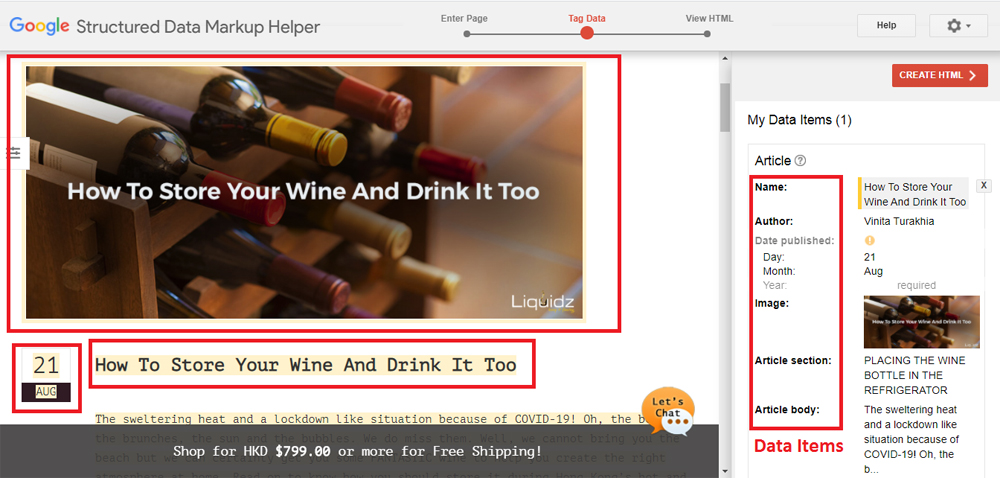
- Continue selecting (i.e. highlighting) other parts of your article e.g. author, date published etc. and keep adding corresponding data items in the RHS pane.
- When you are done highlighting & adding data items, click ‘Create HTML’ button at the top right of RHS pane. This generates the HTML code of your page in the RHS pane with all the relevant microdata embedded in the spots you chose.
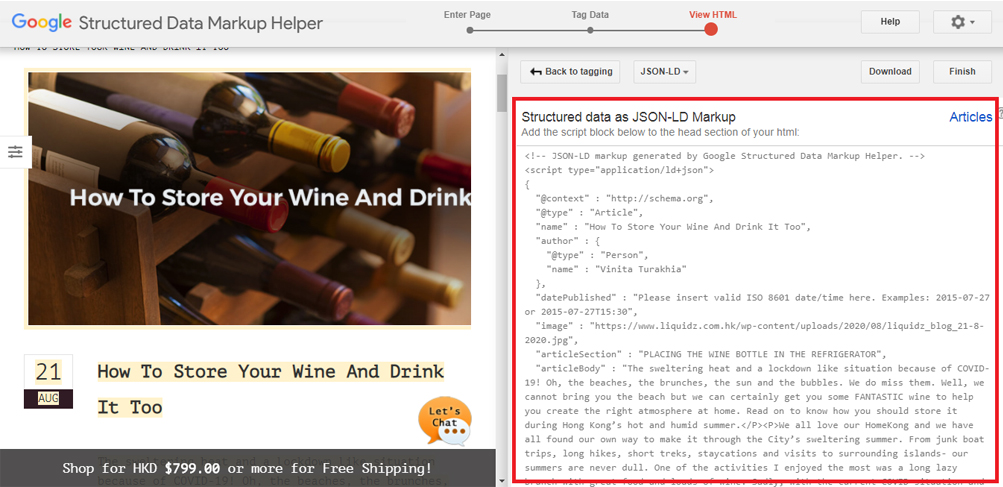
- Download this HTML code (by clicking the ‘Download’ button on top right) & replace the source code of that article’s web page with the downloaded HTML code. Click ‘Finish’ button present at the top right & you’ll be displayed “Next Steps”.
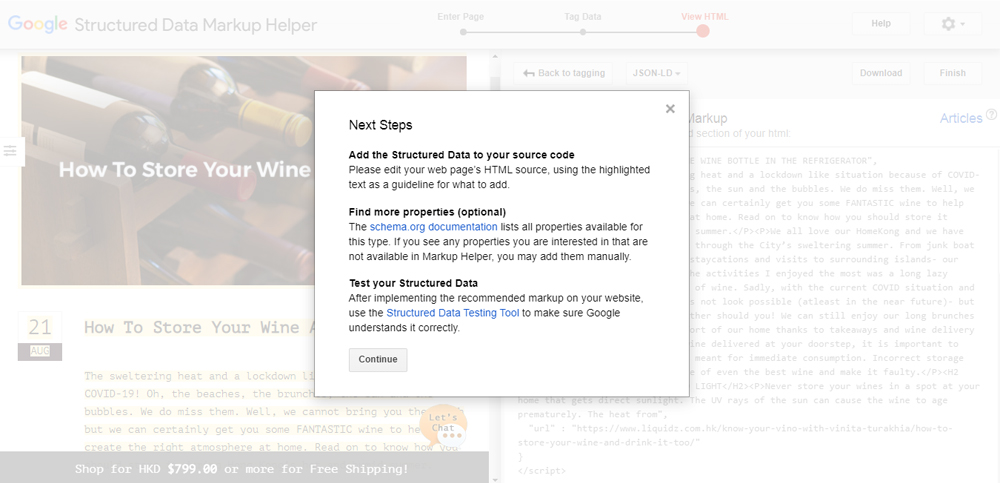
- Now, open Google Structured Data Testing Tool. Paste the updated HTML code of your web page in the space provided for HTML tab in testing tool. Lastly, click ‘PREVIEW’ to see what your page will look like in Google search results.
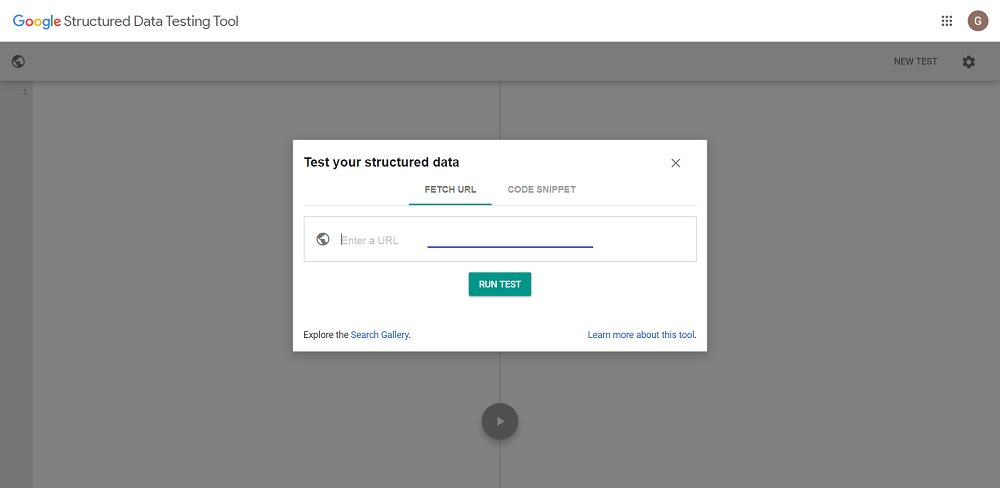
When to Use Schema Markup?
Commonly, schema markup is used to provide additional information about content types like:
- Product
- Place
- Person
- Organization
- Event
- Movies
- Creative work
Let’s see how Product markup is applied for, say, your e-commerce website which sells electronic products & is offering a specific brand of headphone (listed under the ‘Headphones’ category on the website) on sale.
Without any schema markup applied in the ‘Headphones’ page, it will be displayed in the SERPs somewhat like this:

Search engines know that the description below the result link in the above picture comes from the ‘meta’ tag, but they don’t understand its importance to the users. In other words, precise info about your product is still obscure to the users searching for it.
Now, implementing schema of the Product markup in the ‘Headphones’ page will add details like ‘price’, ‘ratings’, ‘number of reviews’, ‘availability’ etc. as shown below, giving more context to your website URL in search results.

Similarly, you can also apply properties of the ‘Offer’ markup such as payment method, aggregate rating, delivery method etc. for the ‘Headphones’ page.
You can find a detailed explanation of the schema markups at schema.org & here is an extensive list of all the markups to help you identify which markups are best suited to your web page’s content.
Companies performing SEO have reported that applying schema markup makes their page rankings jump by 4 positions on average on SERPs. While it is still unclear whether the boost in results can be attributed to schema alone, there is evidently at least some correlation.
With all the potential of rich snippets, it is surprising that only 1/3rd of the websites implement Google schema markups today! Utilizing schema can very directly help your website stand out from the competition in search results.
General Data has grasped the importance of schema markups in SEO & we rigorously implement rich snippets of structured data markup tools in website pages towards effective SEO, which will directly impact traffic and goal conversions.
Reach out to us here for a no-obligation pre-SEO audit & also for more information about how we create SERP success stories.
It was in the summer of 2007 when Chris Messina, a web marketing specialist and an avid Twitter user, suggested to their team to use the “pound” or “hash” character to group related tweets. On 23 August 2007, hashtags came into existence & caught on across the platform. Twitter hyperlinked the hashtags making it all the better & easy for the users.

Today, platforms like Facebook, Instagram & YouTube, as well as other digital marketing agencies, use hashtags to organize & classify content & also keep an eye on what is trending among the users.
So What Is A Hashtag?
A hashtag is word or a phrase starting with the symbol ‘#’ (e.g. #CharcoalDrawing) which helps to increase the visibility of your content among online users.
Today, social media marketing companies consider hashtags as crucial to any marketing effort because people not only publish content but also search for relevant content online.
When your content has hashtags, it has greater chances of showing in the results of others’ queries.
Hashtag Basics
In order to master hashtagging and use it effectively, top digital marketing companies do a lot of research, creativity & innovation. Easier said than done, creating hashtags is the fusion of art and science which these digital marketing agencies are master at. For effectively using hashtags, it is vital to mind & practice these hashtag basics:
Research:
Just as keywords are integral to SEO, hashtags are important to enhance your brand’s presence among social media users. They must be able to see the content you are posting. Research the words & phrases that are being used by the users of your brand’s products and/or services.
For instance, An online store for liquor delivery in Hong Kong – frequently uses hashtags like #hkliquor, #alcoholdelivery, #hongkongwhisky & #keepitflowing, the last one being the motto of this famous store.
Brevity:
Short & easy to remember – this should be the driving force behind creation of hashtags for your content. Your hashtag should not be a sentence (certainly not on Twitter!). Try to keep it under 20 characters. #ThisIsNotAGoodHashTagForYou!
Specific:
Make sure your hashtag is not obscure to online users. For instance, to raise the visibility of the products under its ‘fashion’ category, Amazon can use #apparelsonline or #amazonfashion. Evidently, the second hashtag is more specific about both the brand as well as its category. Its clarity will be easily understood by a large user segment.
Quantity & Combination:
Using a number of relevant hashtags in clever combinations. Try to create a mix of broad (e.g. #movietickets) and specific hashtags (e.g. #BookMyShowTickets). Don’t create so many hashtags that users take your post as a spam. There is no ideal number for how many hashtags to be used, though on Instagram 4 to 8 good hashtags for a content are sufficient.
Follow Trends:
To garner maximum visibility for your content, always look for trending hashtags and try to model & embed them to complement your need. Social media marketing companies often use tools to identify trending topics among users or in a geographical area. You don’t want to target users in New Delhi if your business focus is in Mumbai!
#So_Who_Uses_Hashtags?
Any individual or a group of individuals active on an online platform supporting hashtagging, can use hashtags. Posting their content linked with relevant hashtags increases content’s visibility to others on that platform.
For instance, an enthusiastic travel blogger, say Ryan, active on Instagram will use hashtags like #travel, #travelphotos, #travelblog, #exoticplaces etc. along with a couple of more related hashtags.
When another Insta user will look for pictures about travelling, he/she may search for ‘travel photos’ on Insta and Ryan’s pics will show up in results if he has used relevant hashtags.
A company running an online business engages in posting a lot of targeted content. Each content has many relevant and clever hashtags to increase its outreach among both the users and non-users of its brand. It also helps that company to fathom what the users are looking for.
At the moment of writing this article, Instagram is returning 498 million results for the search ‘#travel’ while the hashtag #food is returning 393 million posts!
Such is the power of hashtags to group similar content & indicate how prominent a content is among users.
#Why_Use_Hashtags?
Hashtags improve user engagement with your content by increasing its visibility. In a way, it makes your posts visible in the conversation.
Creating a branded hashtag e.g. #AmazonShopping, augments the promotion of your business and also drives online conversation about it.
They can be used to rapidly drive a social cause to a large number of people in a short time. For example, #EachforEqual and #IWD2020 were used across social media platforms, including LinkedIn, on International Women’s Day.
Using a hashtag contextualizes your content, thereby reducing the number of character/words you may need to type otherwise.
For instance, NASA used hashtags #Apollo50th and #WorldEmojiDay on 17 July 2019 to indicate that NASA was celebrating the anniversary of moon landing and also participating in conversation about emojis.Hashtags are like breadcrumbs for your audience (and others as well) to find you. If you are into posting cocktail recipes on Instagram, some connoisseur may like your posts and you may gain a famous person for a follower!
Driving social media marketing is a humongous task that requires a lot of foresight, calculation & well-thought out experimentation.
If you’re looking for help with social media management, search engine marketing, SEO and other online marketing services, the team of experts at General Data can help you generate more visibility, leads and sales of your products and services.
We specialize in formulating social media strategies, creating accounts and setting up profiles, run successful campaigns, do competitor analysis & draw insights to help your business expand further.
For an exhaustive account of our services, feel free to reach out to us at General Data.
SEO copywriters create content with two objectives in mind:
- Content should be valuable, compelling and useful in some way to the reader
- Content should build the credibility and ‘domain authority’ of the underlying domain for specific phrases, which is achieved by seeding the content with carefully researched search terms
Search Engine Optimization copywriter creates content which is valuable, compelling & useful by seeding the content with specific keywords which help to improve the content’s ranking in Google for selected keywords.
Copywriting for promotions, advertisements & articles, while balancing the two above objectives, a skilled copywriter incorporates some of the best SEO practices to tailor the content to meet the audience’s search behavior & carefully embeds words in the content that will appeal to them. The important thing to stress here is the relevance of the content. The content shouldn’t read like it’s been written for the sole purpose of SEO by maximizing the use of keyphrases – a ‘black hat’ practice known as keyword stuffing.
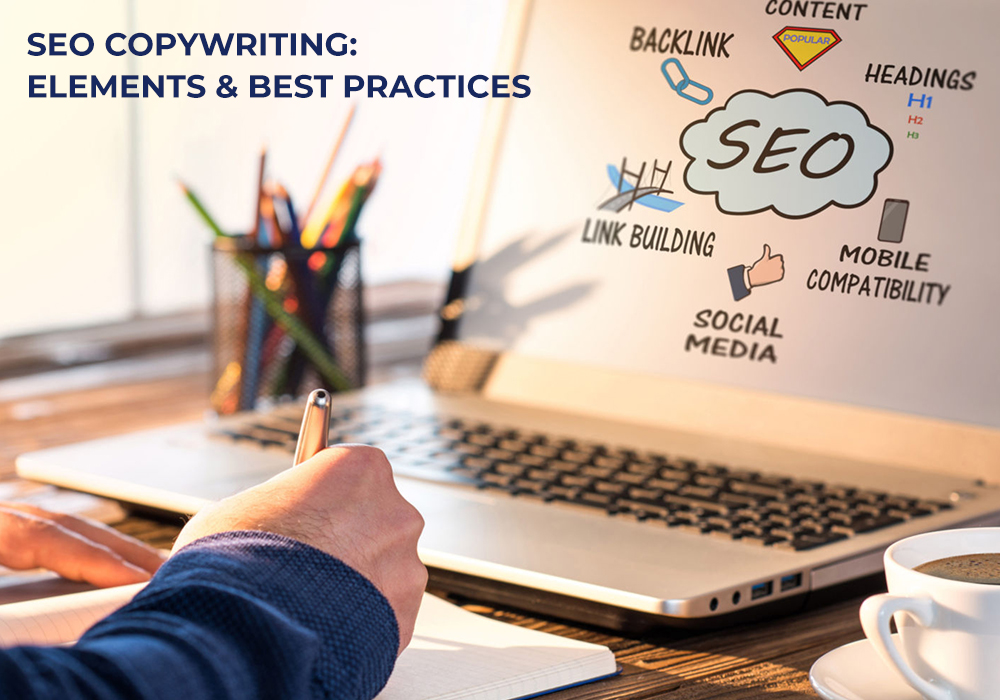
Importance of SEO friendly content
SEO’s purpose is to increase the quantity and quality of inbound traffic to your website. Content quality has been found to be one of the most important ranking factors in Google’s ‘search algorithm’. Google and other search engines are continuously striving to make their algorithms ‘non-gameable’ – which means they try to dissuade websites from manipulating search results to the extent that a more relevant competitor website might lose out. To that end, search engines stress the importance of creating natural content, the focus of which should be readability by users and NOT search engines.
While we strongly encourage content creators and SEOs to generate content with that guidance in mind, it’s pointless to ignore the necessity of having relevant keywords seeded in your content. Even though your webpage might be the most detailed, informative authority on a given subject, if people are searching for term ‘Xerox services’ – a trademark that’s been genericized – and you make no mention of Xerox and instead solely use the phrase ‘photocopy services’, as smart as the algorithm is to consider both words interchangeable, there is a good chance you’ll still lose out on SERPs. This is a simplified example, but the underlying idea is the same when it comes to the importance of optimizing content from an SEO perspective.
Elements of SEO copywriting
The key elements to consider when optimizing your content from an SEO point of view are:
Title or headline:
Give your article a crisp, catchy title or headline, while trying to ensure the keyword you’re trying to optimize for is part of this H1 title. H1 titles tell crawlers the primary purpose of the page.
Content:
Prioritize generating content that truly benefits the user in some way, the objective should be to meet a need, to solve a problem. Also, try to mix in long and short tail keyphrases into the content.
Meta-description:
When users search for keywords relevant to your page, search engines look for meta-descriptions to understand the content topic. These meta-descriptions are usually placed (as concise explanation) in the <meta> tags in the HTML code of your page.Keep the description very relevant & up to 160 character long, with keywords placed tactically in it.
Keyword frequency:
When users search for keywords relevant to your page, search engines look for meta-descriptions to understand the content topic. These meta-descriptions are usually placed (as concise explanation) in the tags in the HTML code of your page.
Keep the description very relevant & up to 160 character long, with keywords placed tactically in it. These meta descriptions also appear as the descriptions you see below the links in search results. So ensuring they immediately convey relevance to a searcher is essential to maximizing click throughs.Page links:
Page linking tells search engines that your content is sufficiently connected to other relevant pages and content, whether on your own domain or on external ones.Internal and outbound links – especially the latter – tell search engines you’re not afraid to redirect users to other places where they may find other relevant information and resources.
7 Best practices for SEO content writing
Add bucket brigades:
These are words that impart conversational value to your content, making it easier to read and relate to. For instance, writing ‘here is the deal’ in a content meant to go live for flash sale of particular brand of clothes, adds urgency to the experience of user and nudges it closer to make a purchase.
Use longform content:
A very direct correlation has been observed between the length of an article and its ranking position. Given two articles on the same topic, the one that is ‘feature length’, or simply put, longer, will almost always rank better.
Some interesting sub-headings:
So we know long-form content is essential. Obviously, people would spend more time reading a bigger article if it was broken up into sections and not just one big wall of text. Breaking up your article well into subsections with clear, descriptive H2 & H3 headings is very useful.
Call to action buttons:
Adding CTA buttons like ‘click to share’ at the end of the content, prompts the user to share your content with somebody else that might it relevant quickly and seamlessly. The bigger your potential audience for a particular piece of content, the wider reach simple CTA buttons will enable.
Copywriting:
Use lists whenever you can! Write with a target audience in mind – consumers are different from professionals, b2c content writing is different from b2b. Use a combination of short and long sentences, space out your content, readers shouldn’t be overwhelmed visually. Use simple, easy to read fonts like Roboto and Open Sans instead of flowery ones that just ‘look nice’.
‘Here’ & ‘Now’:
’10 Crazy Steps To Boost Your Conversion Rate Right Now’,‘Learn to Improve Your Page Rank in 5 Minutes HERE!’ – these kinds of headings immediately draw audiences in. We hate clickbait as much as you do, so we really don’t advocate making it seem like you have a magical answer for something from the outside while in reality the base content is but a shadow of that magic. Use catchy headings, but back them up with substance.
Keep tabs on keywords used by users:
You can use Google Keyword Planner to know what keywords are being searched for in your industry.
Also spend some time researching how people talk about topics related to you on social channels, on forums and message board like Reddit, etc.
For instance, before publishing a content on ‘best home redecorating tips’, look up this topic on Google and glance through the first few search results to get an idea about keywords.
If you found this information useful and would like to learn more about our SEO services, and how we can help increase the visibility of your brand online, do get in touch with us. We’ll love to learn about your objectives and create a customized, free SEO audit report for you.
Digital world is here to stay and it is a platform to display your skills. You can have an amazing website or a Blog with unique content but if you don’t work hard to promote it as well it will not pick up traffic. SEO – Search Engine Optimization, SMM – Social Media Marketing, SEM – Search Engine Marketing, PPC – Pay-Per-Click are few terms which you are familiar with. If we want our website to be famous for originality or as most searched/visited site or get crawled by search engines, namely Google (https://youtu.be/0eKVizvYSUQ) - the first step would be to know meaning of these terms and then use ways and means to make your site earn the most hits/CTR (Click through rate). This indicates the need for professional SEO services provided by the SEO companies in Mumbai and other cities. There are specialized services provided by SEM Agencies, PPC service providers, social media marketing agencies, digital marketing companies, SEM agencies and so on to help you build traffic on your website.
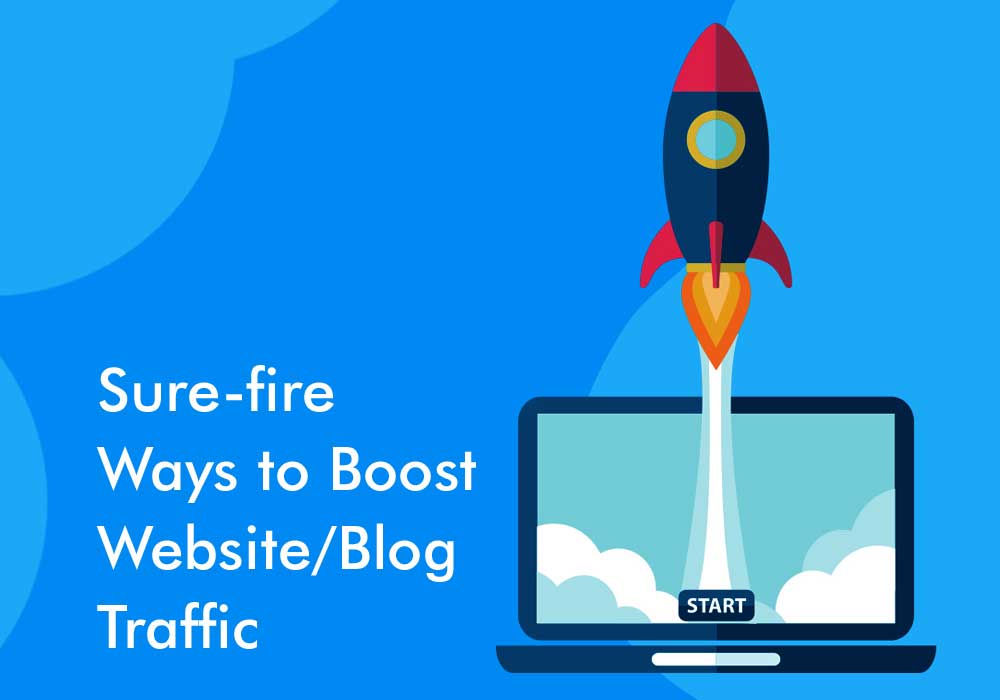
Following are a few pointers to guide you in right direction:
- Firstly in the oversaturated web content getting recognition is quite a feat. So, you have to make sure the write-ups are original, user-friendly, engaging and updated.
- Secondly to give your site the necessary push that web crawlers can shortlist your site on (preferably on first page of) search engine.
Now for sure-fire techniques:
Keywords:
You would need to research your keywords that is used by search engines to pick/select your article. One has to recognize them and write articles with using them (preferably in first paragraph) for crawlers to find.
On-page/SEO:
Usage of keywords, attractive headings, fresh content, easy loading etc. help to promote your site.
Off-page/Backlinks:
Backlinks is also an effective technique to promote various blogs/content to increase search engine crawling. This is an off-page action (taken outside your site) with embedded links to other articles/blogs/urls to interlink and boost ranking. Backlinks tends to rank higher on SERP.
Social Media/SMM:
Social Media dominates this electronic era so it’s imperative to publicise your site on it or as the online word calls it “trend” it. Facebook, Instagram, Twitter, are the most basic trending social media platforms. Depending on your content and website you have to consider promoting it. Pictures, tweets, videos, instagram stories help approach your target audience to your site.
SEM:
Search Engine Marketing is pay-per-click (PPC) based marketing. You create an ad with respect to your site and pay the search engine to display it on the page. Wording and content determine the chances of your ad being clicked on and user visiting your site. This ad is strategically posted to target specified audience. This is a surest paid method to promote your webpage rather than waiting for organic traffic referrals from search engines.
Email Marketing:
is another sector that needs constant attention. You may get good traffic on your site by great content, SEO and other techniques but to keep them happy and continue make them return to your page is equally important (as well as build more traffic). Audience has expressed their interest but to keep their curiosity going you need to send newsletter about latest blogs posted, give special offers, send specific segments if it caters to a particular group, share links to social media sites to encourage/remind them to follow you etc. Some companies also provide email marketing services to support and build your site.
Slack Community:
There are some slack communities which can be joined to connect with target audience. They can be a small group who could be interested in topics displayed on your site. If it does not work out in your favour then look for other community. This is a great platform where real time chatting can be done to promote direct contact to cater to the wants and needs of potential users. You will need to gradually build rapport and goodwill which inturn, will make them want to refer your site. You would have to keep updating your posts and answer questions and tactfully share links.
Blog comments/Forum interaction:
This is an effective SEO link building technique as well. By making thoughtful comments relevant to your web page you can interact with your audience directing traffic to your page. You can even maintain a spreadsheet of all the relevant blog posts for quick reference.
Podcasts:
They are opportunity for marketers. All you need to do is present your idea to the host of podcast explaining how you could be an asset for their future episode. Then appear on it with information that is interesting and enlightening, along with promoting your site and asking them to visit your site for more detail. Plus make sure your give your name, links and other details clearly for viewers ease to visit your page.
Quick Response Codes:
An effective underutilized tool to increase direct traffic to your site. Everyone carries a mobile phone which makes scanning QR codes easy. Effective placement of QR codes on business cards, flyers, posters, social media sites like Facebook, etc. will give quick access to direct traffic to your website. They can be generated using a free QR code generator to create a unique code for user to scan.
Sites don’t get recognized in a day one needs to build credibility and communication. You will need to present information not bombard it. Answer questions and insert links to help your piece not force links to make it jazzy. If any questions seems out of context but remotely associated with your topic it is beneficial to answer it with research and helpful links to build healthy relationship. This will help the user to share info with other users diverting traffic to your site. Bottom line is it is a digital world and marketing is a task which needs constant upgradation and strategies so the professional guidance of digital marketing agencies comes in handy.




















